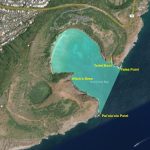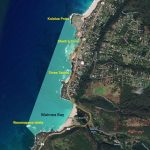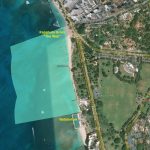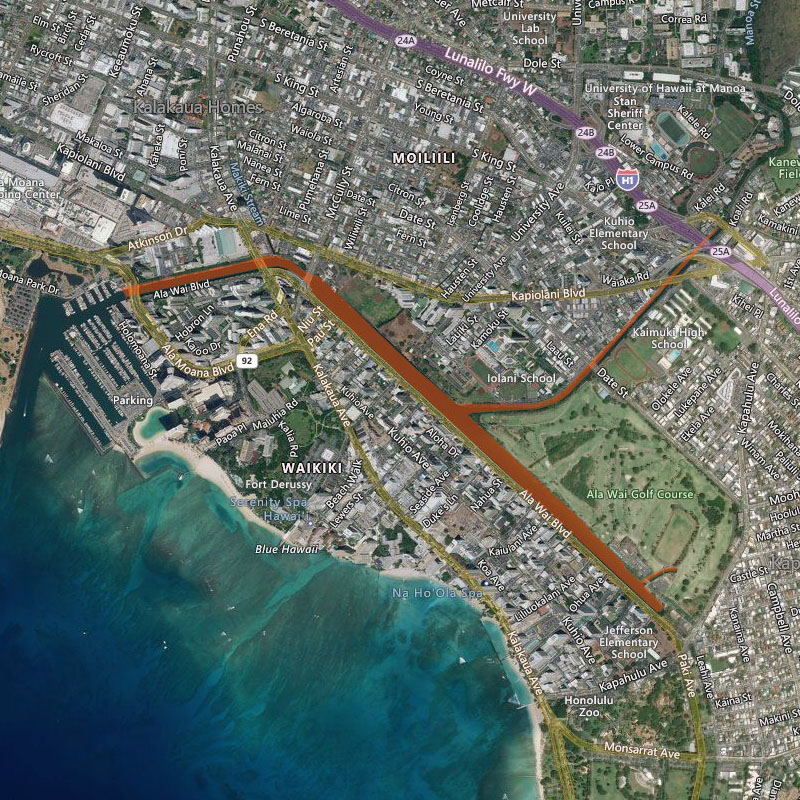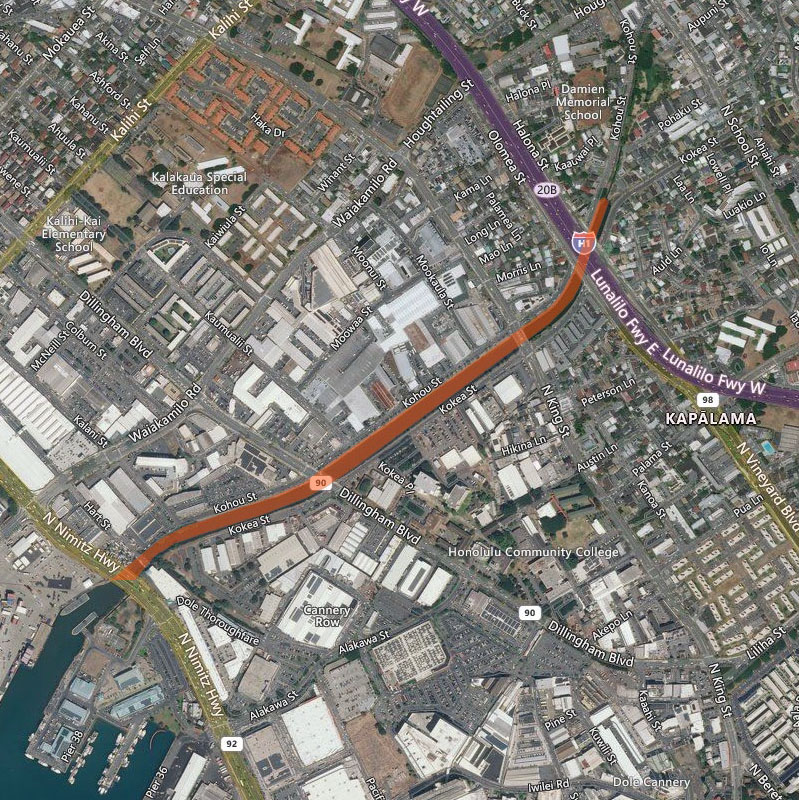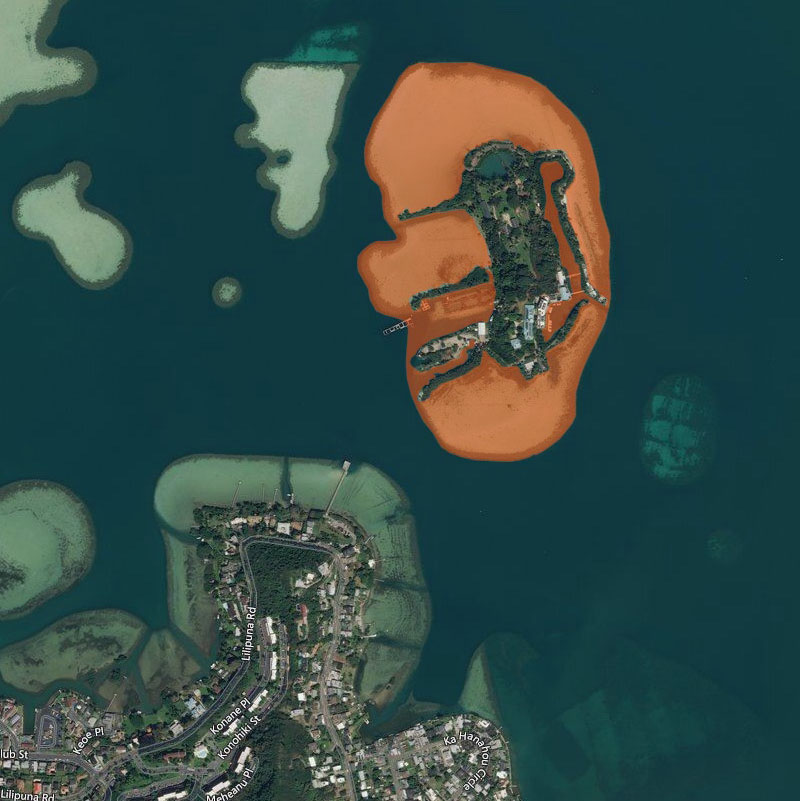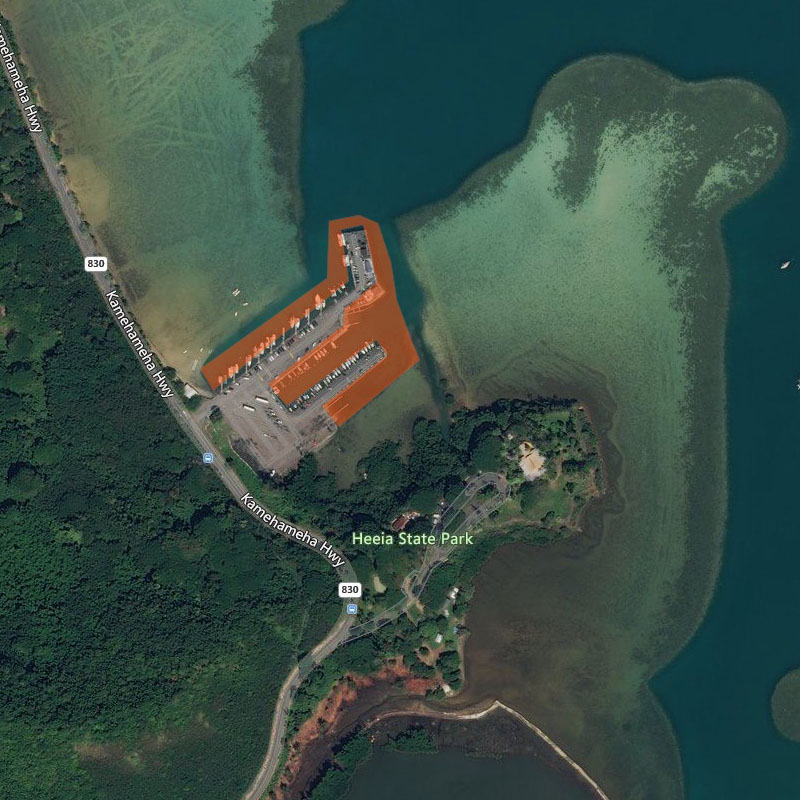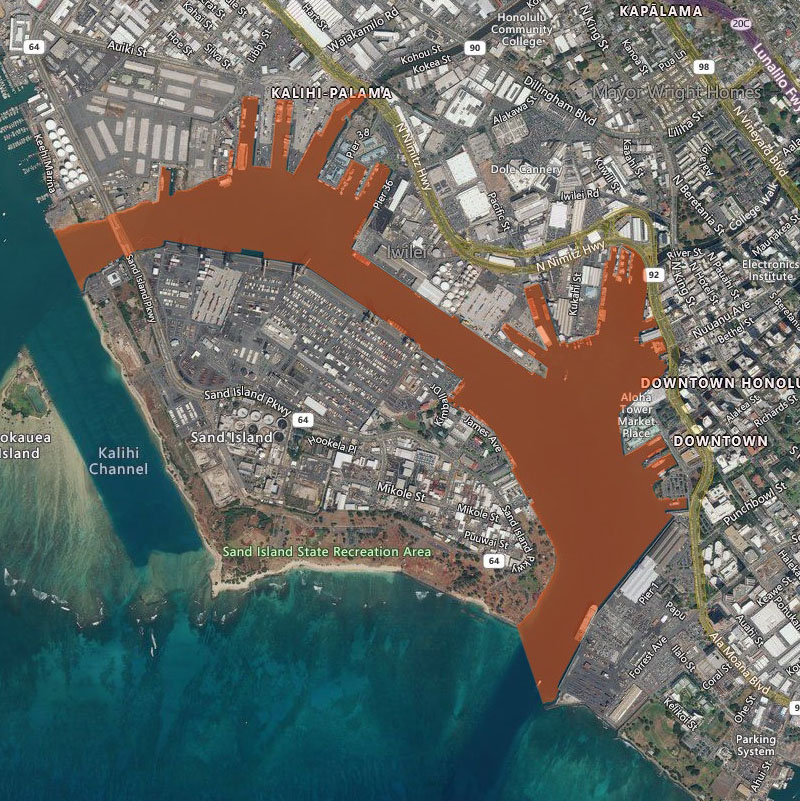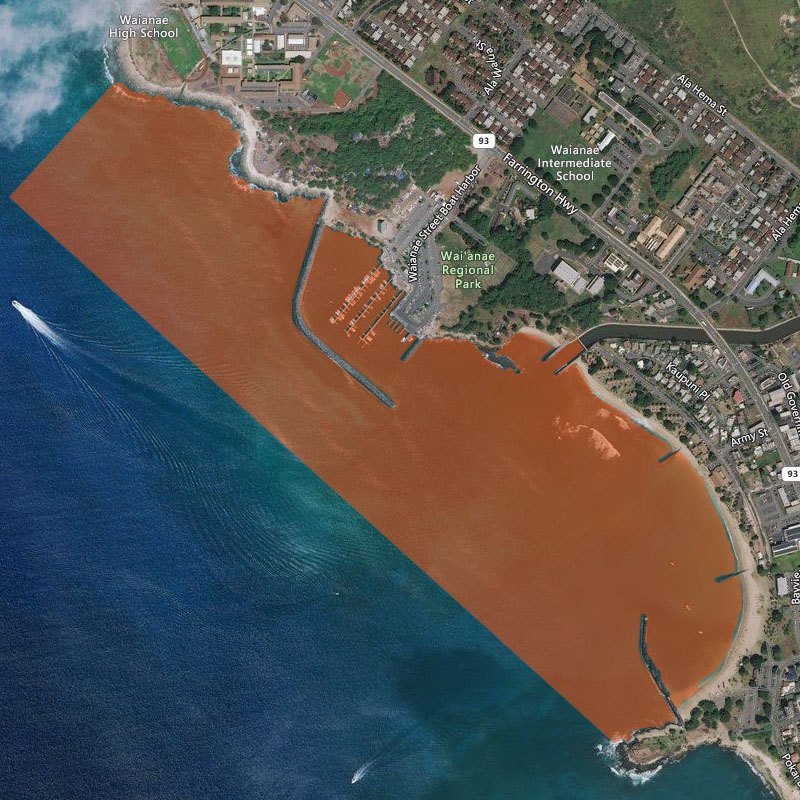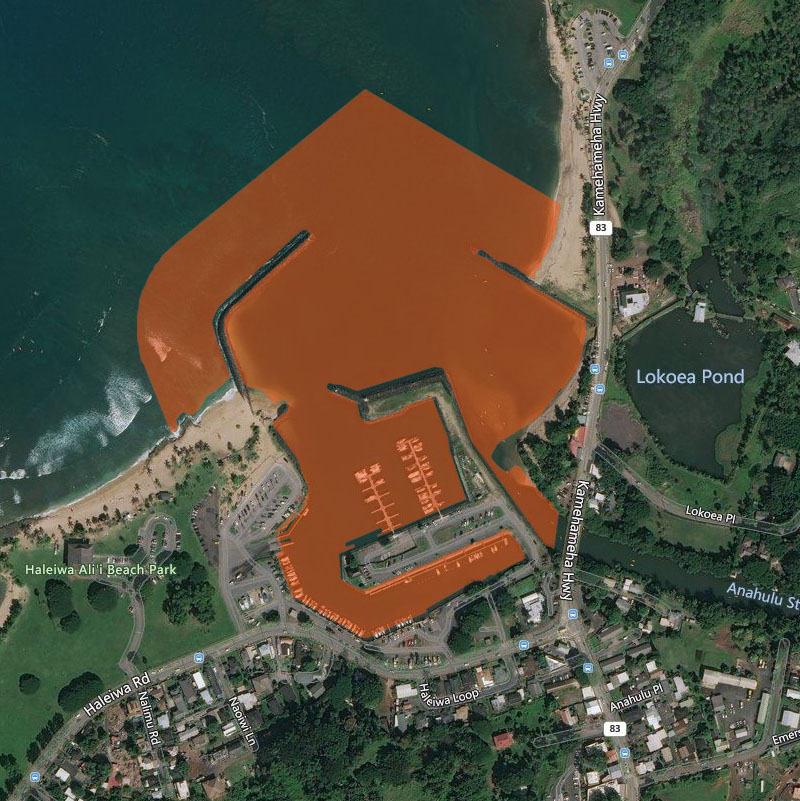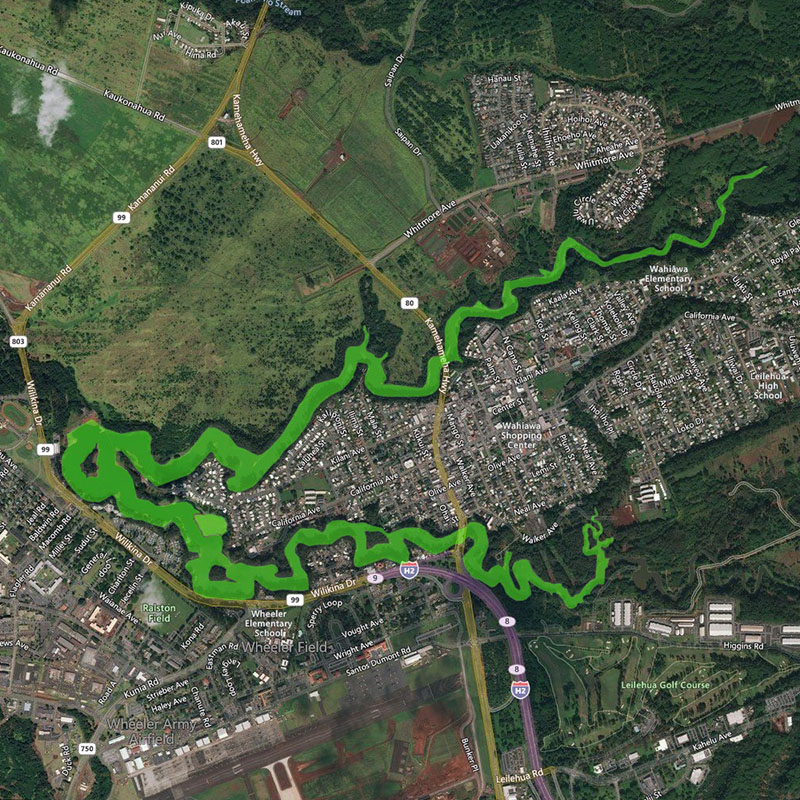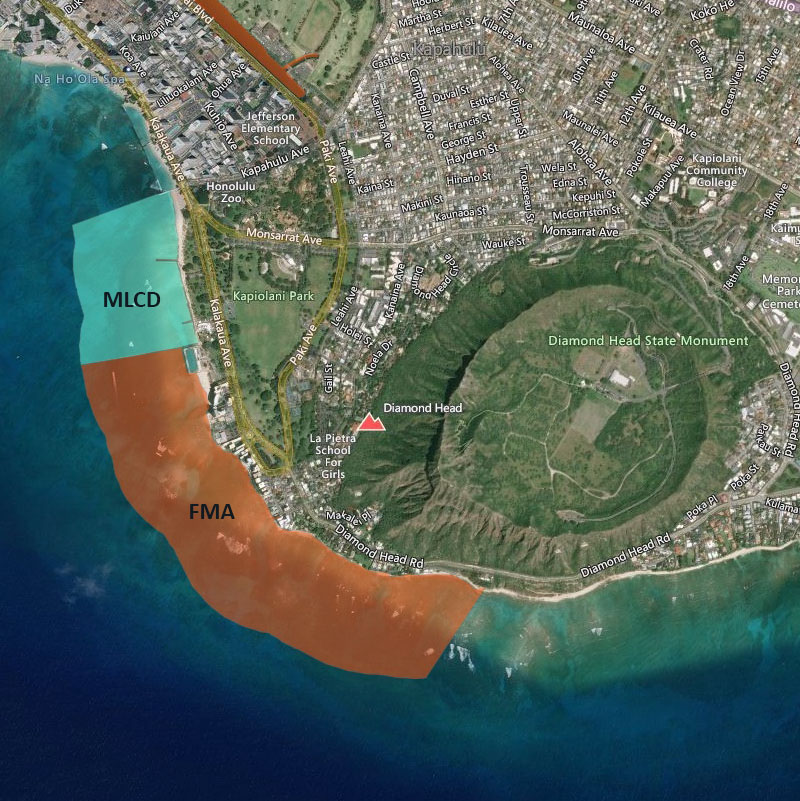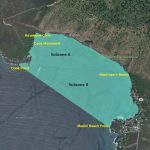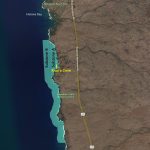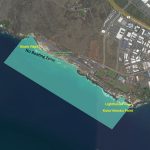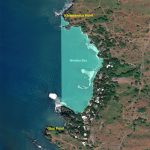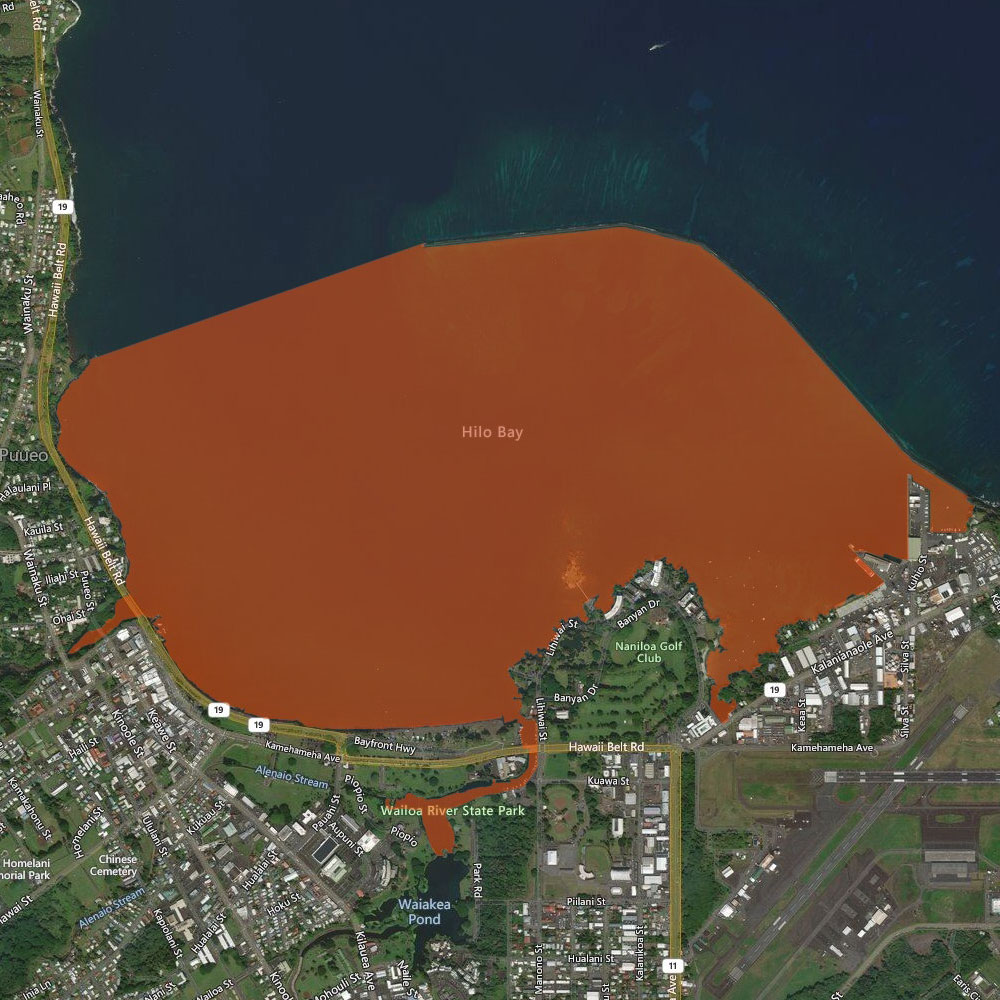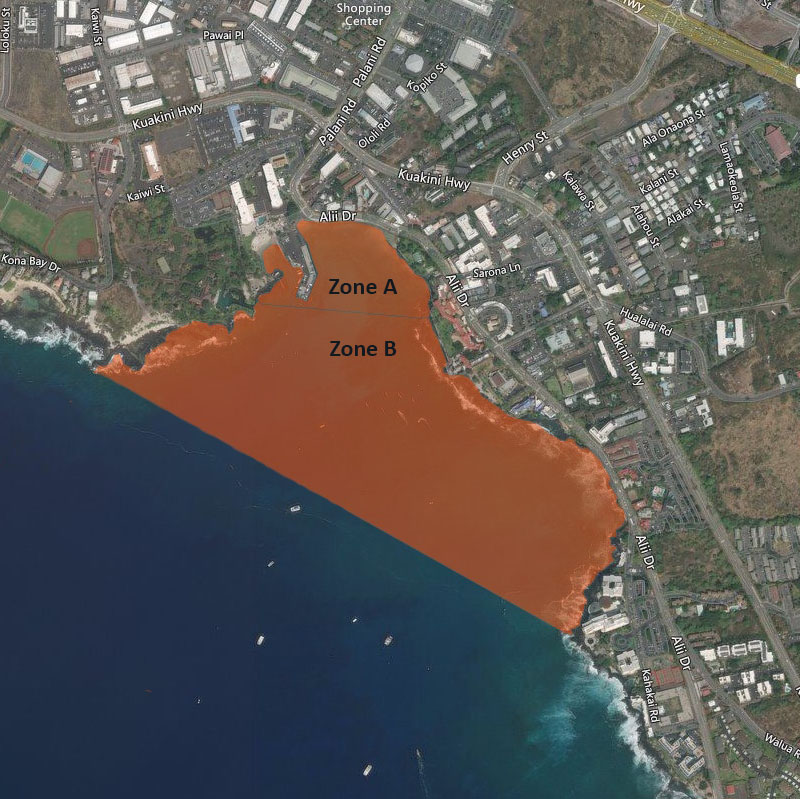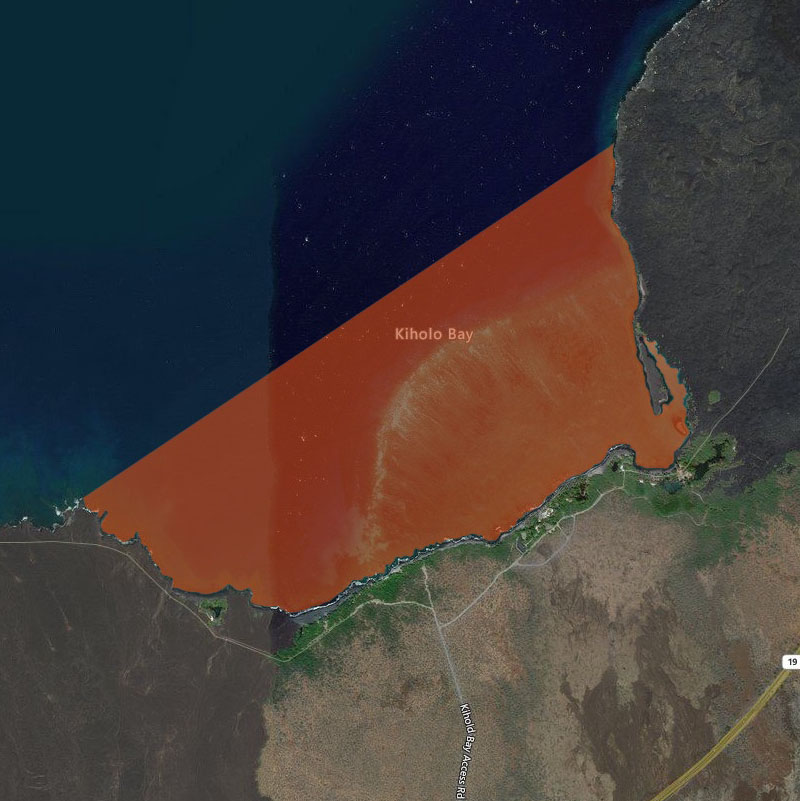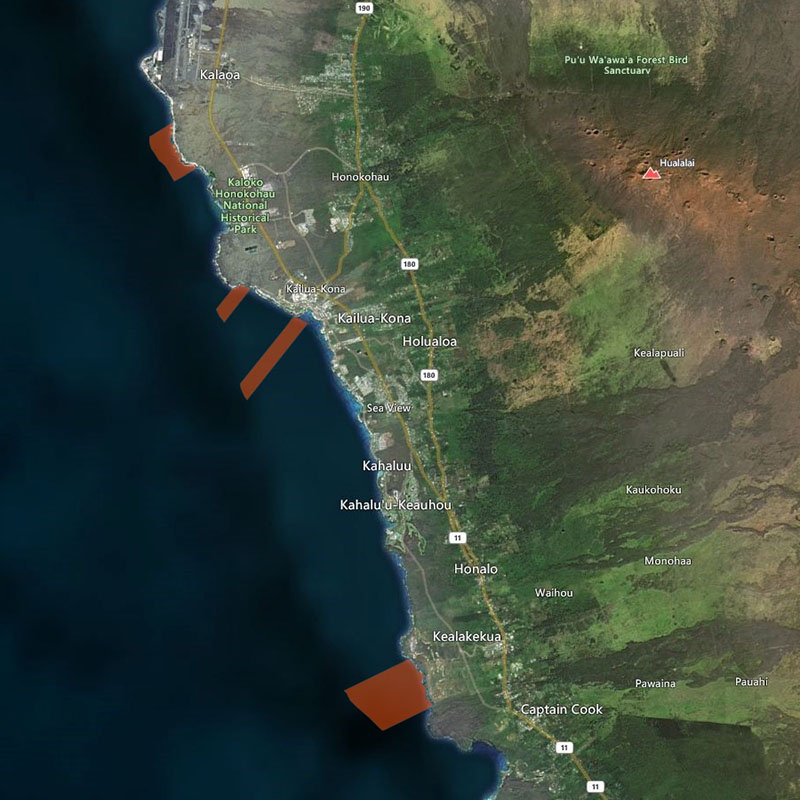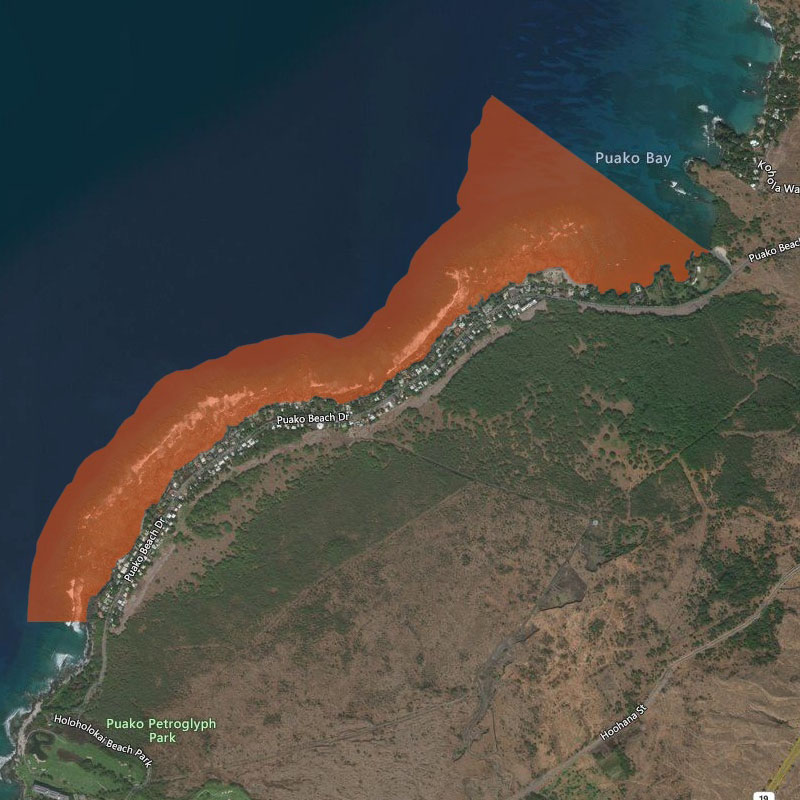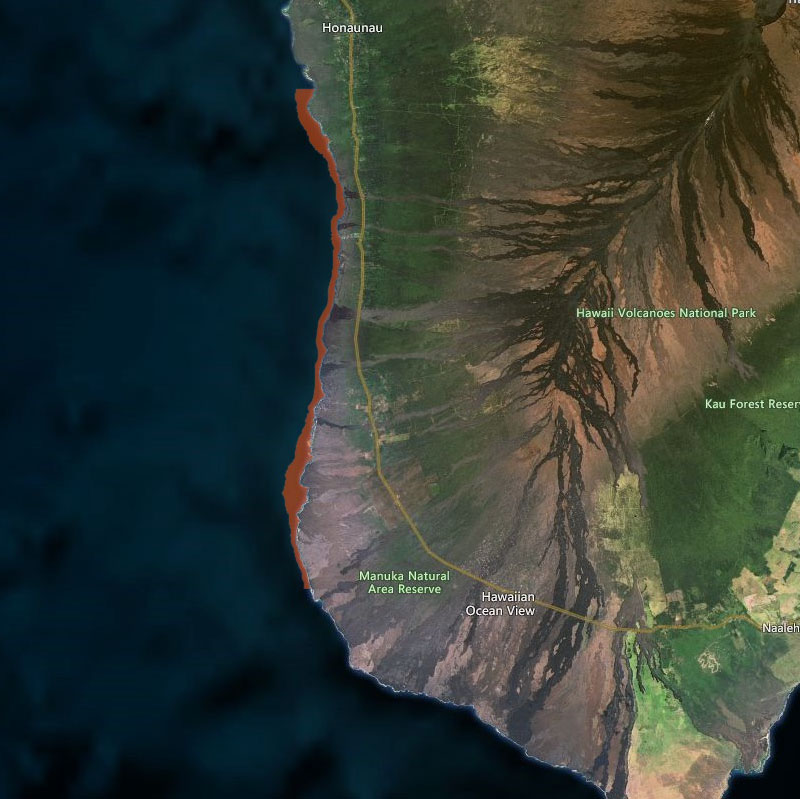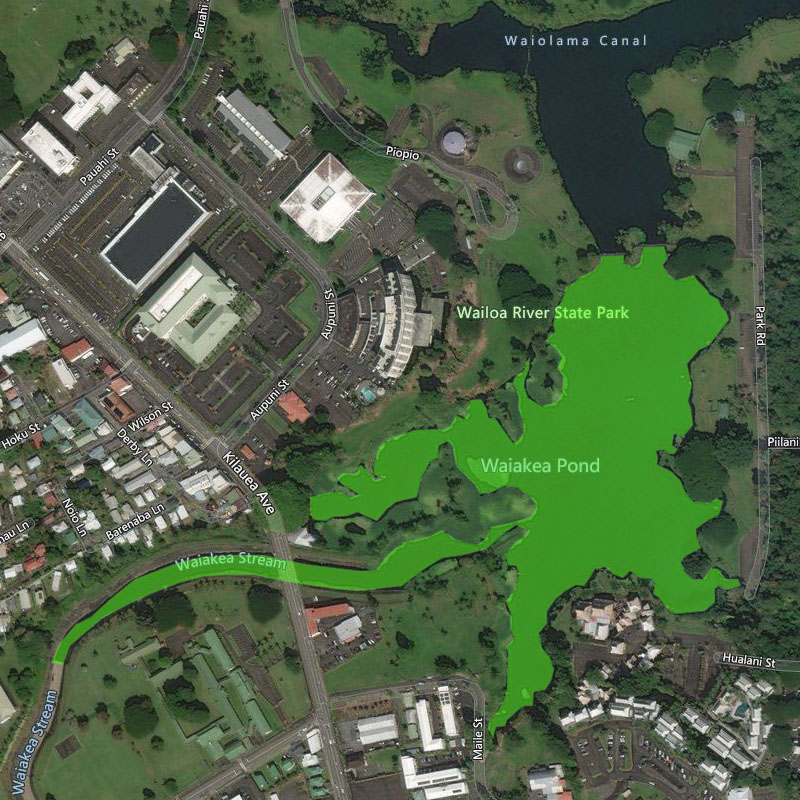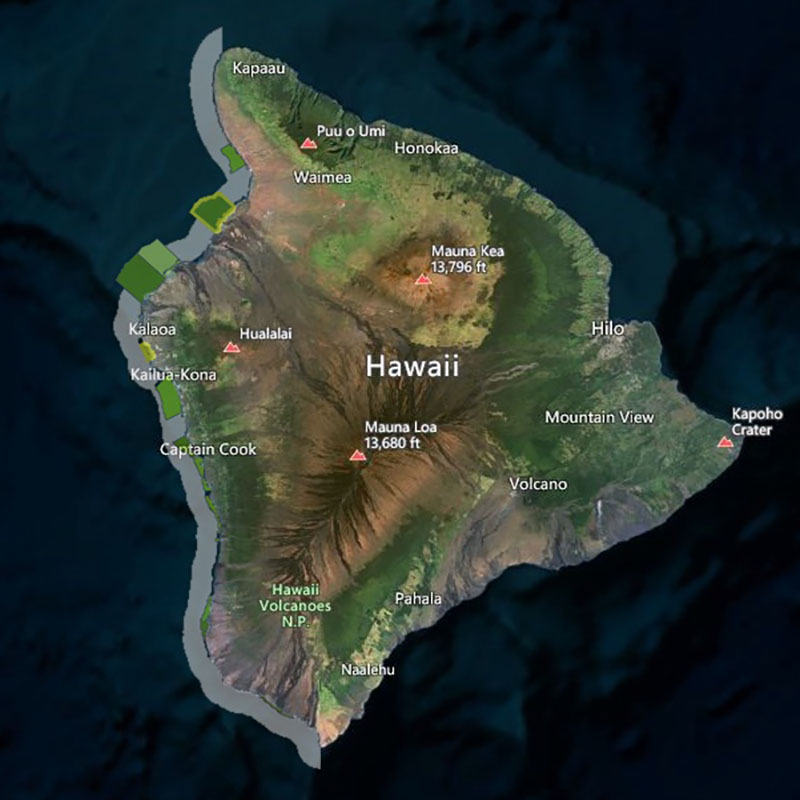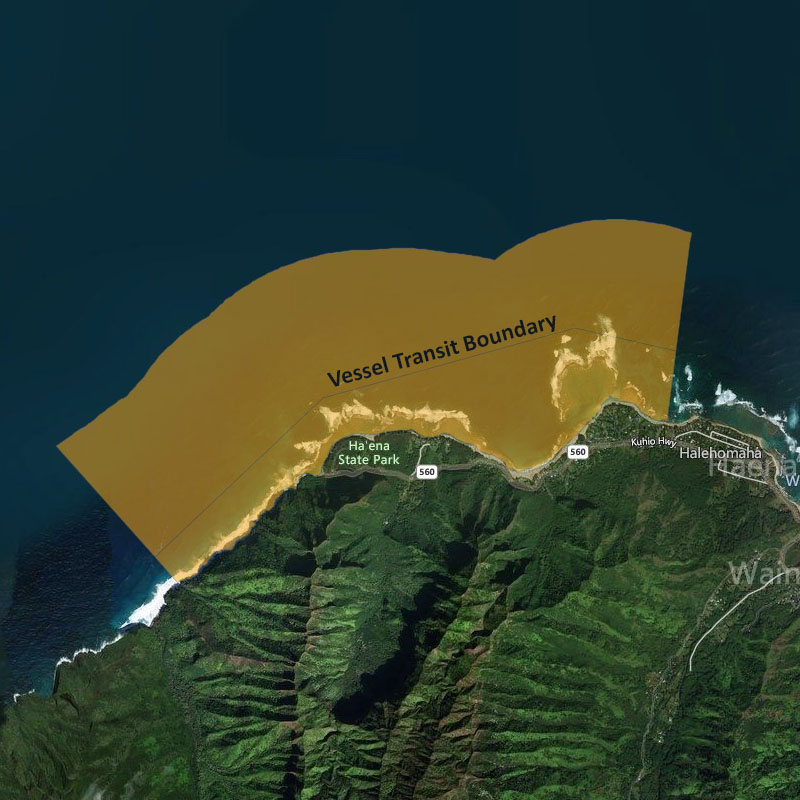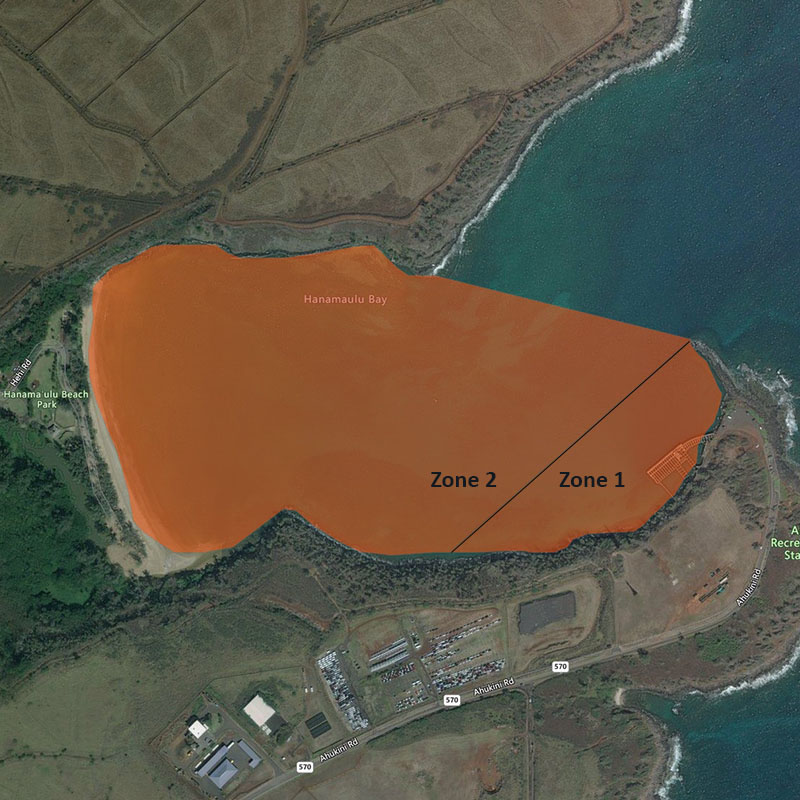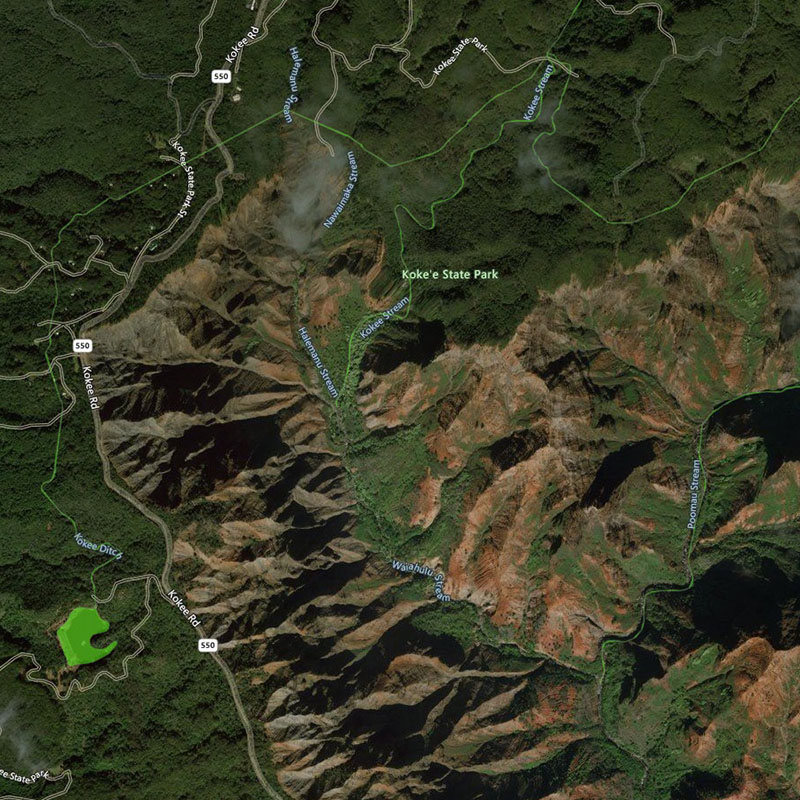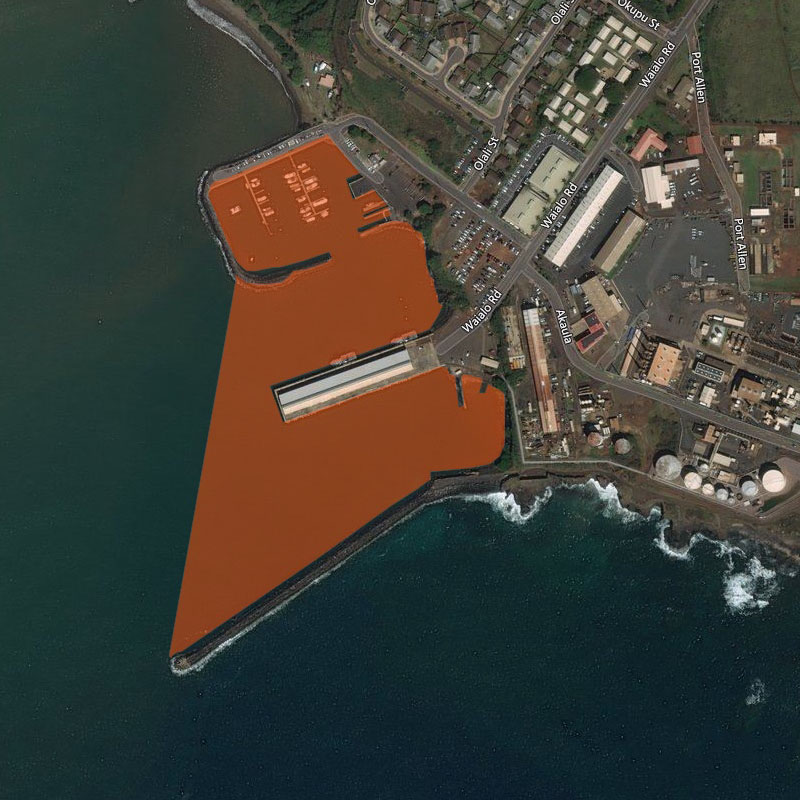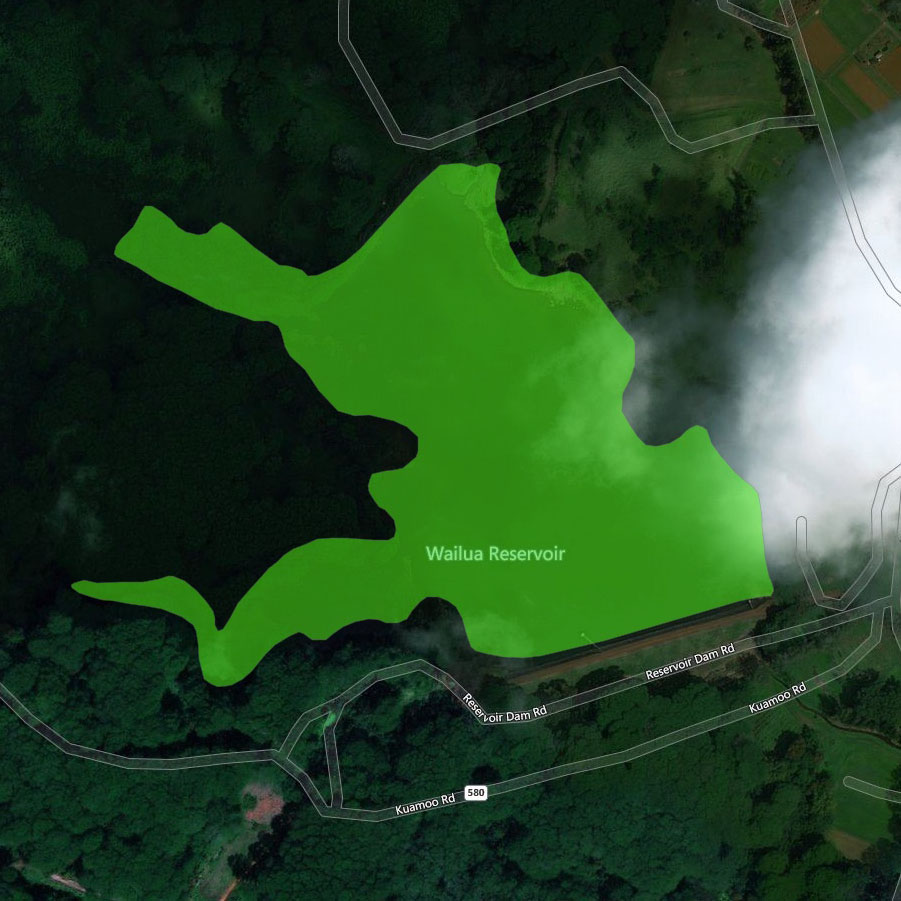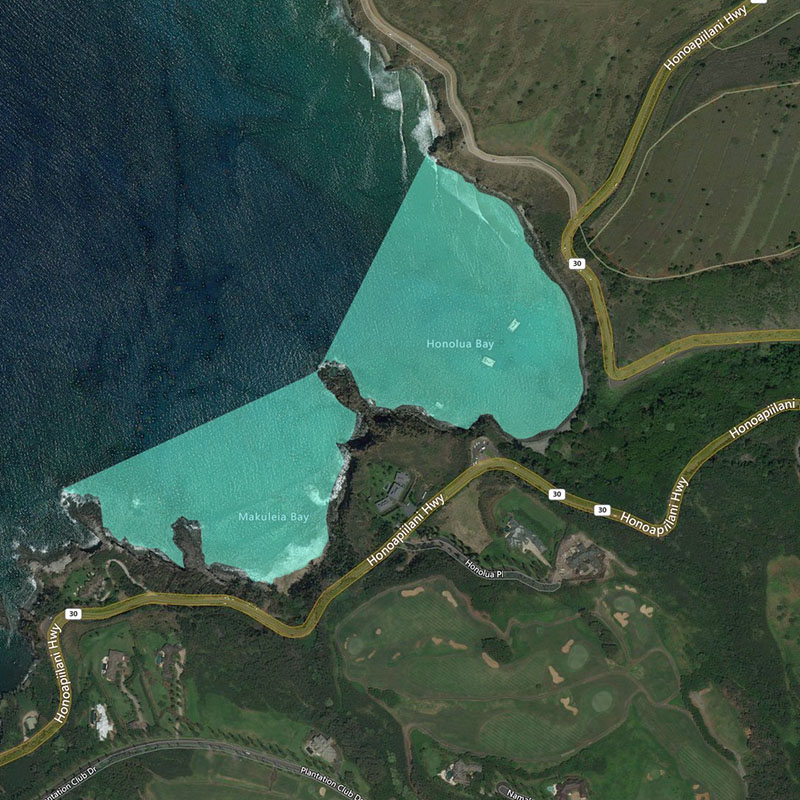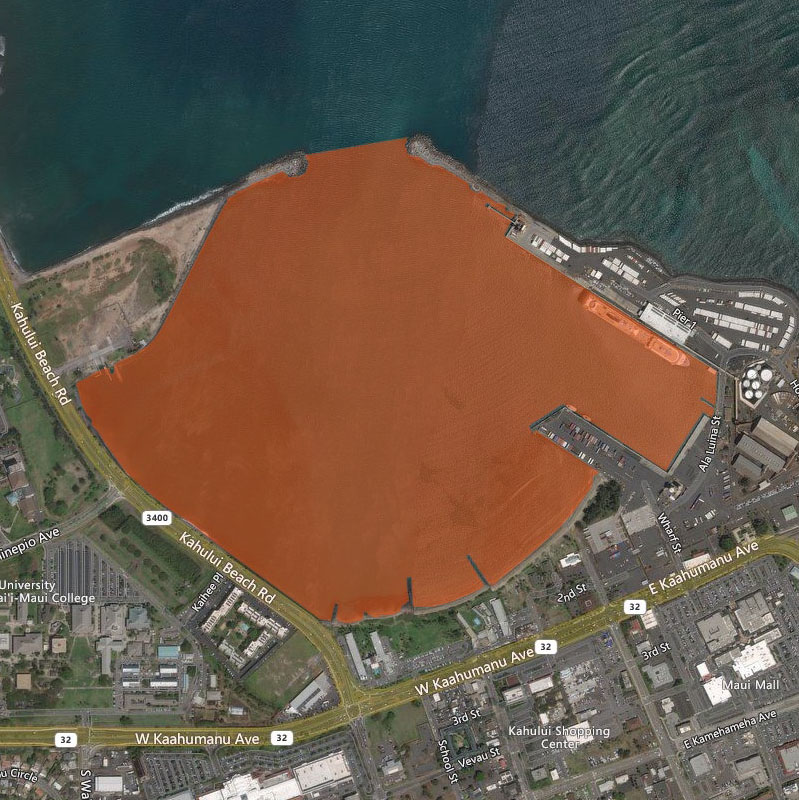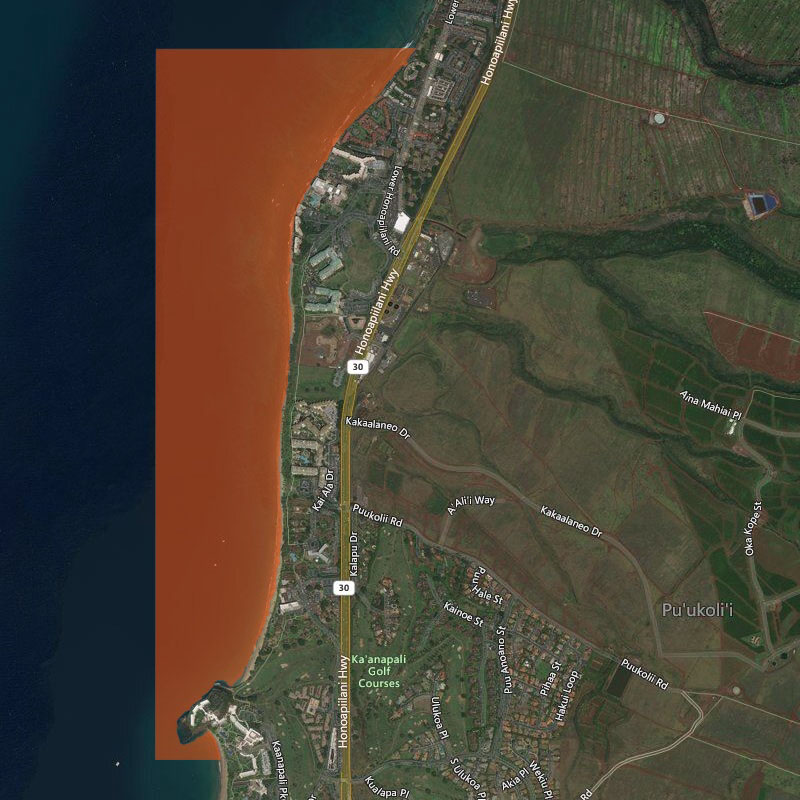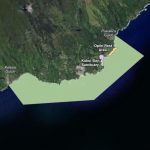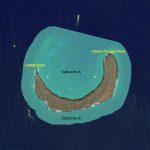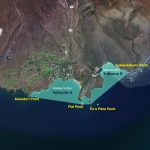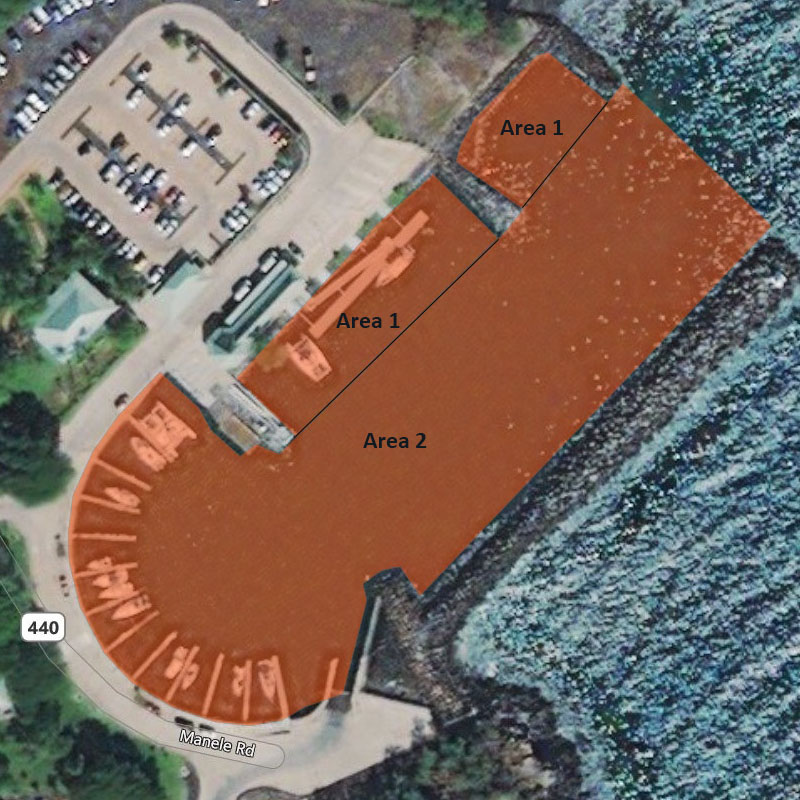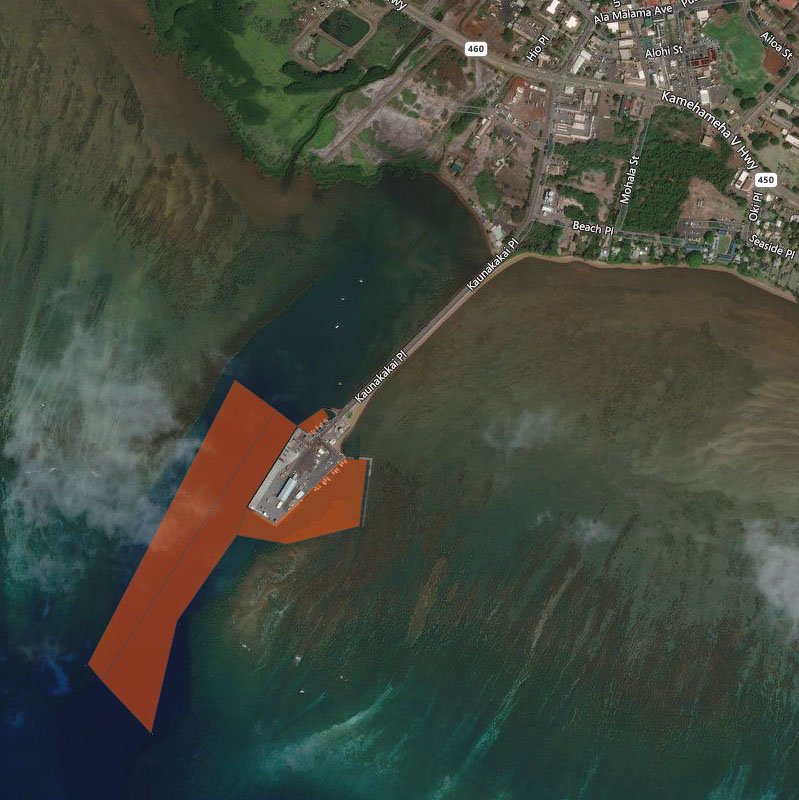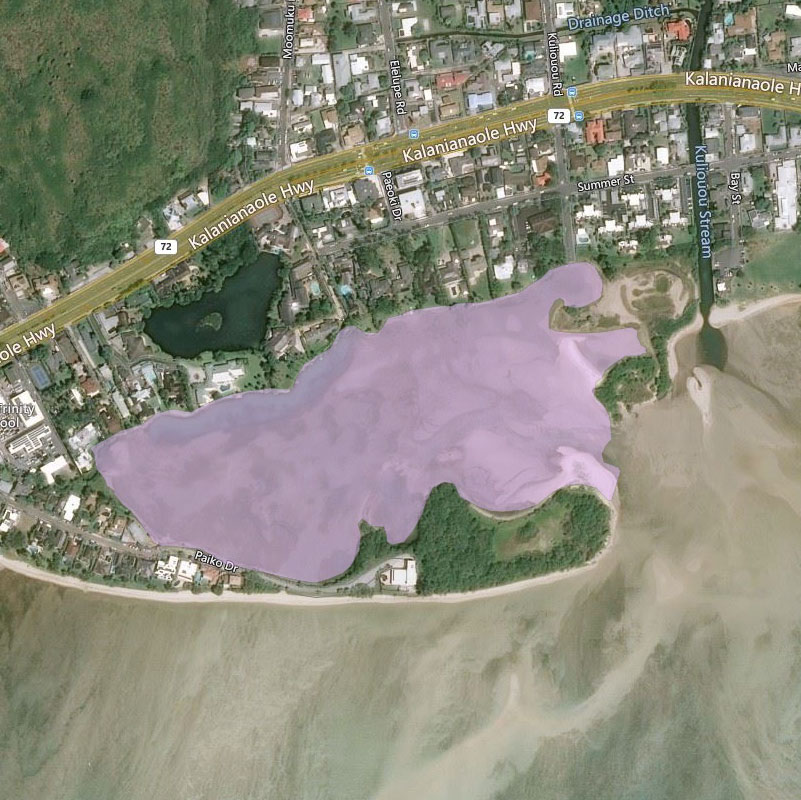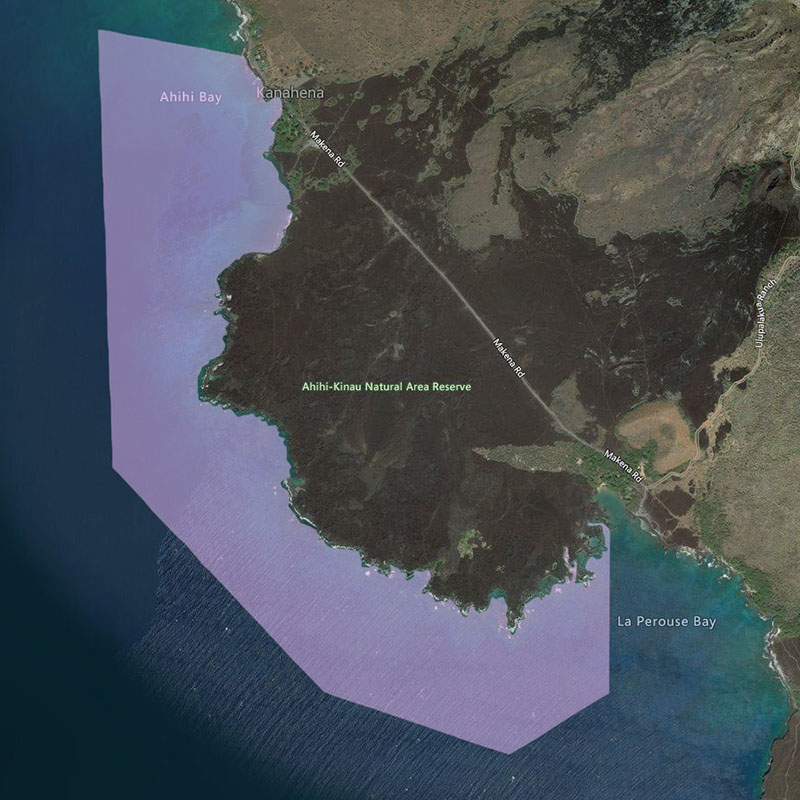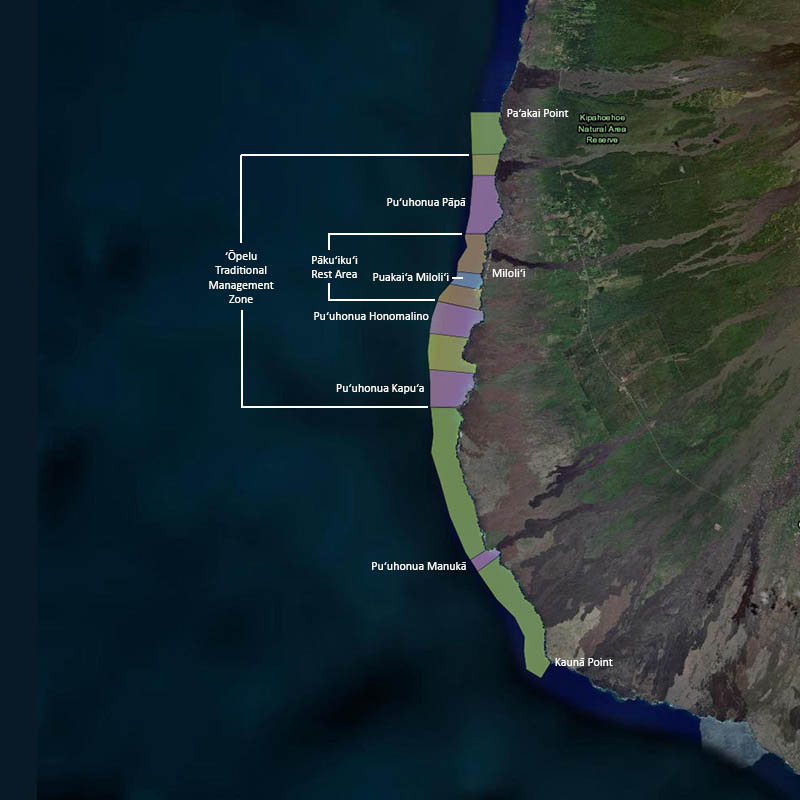Regulated Fishing Areas on Hawai’i Island
Hanauma Bay MLCD
| Location | The Hanauma Bay Marine Life Conservation District is located offshore of the City and County of Honolulu’s Hanauma Bay Beach Park on the southeastern coast of O‘ahu, from the highwater mark seaward to a line from Palea Point to Pai‘olu‘olu Point. Hanauma Bay has also been designated as a State Underwater Park of the Division of State Parks. Rules of the State Park system also apply to the use of the underwater park. |
| Permitted | To possess in the water a knife for personal safety. With a permit, to engage in activities otherwise prohibited by law for scientific, propagation or other purposes. |
| Prohibited | To fish for, take or injure any marine life (including eggs), or possess in the water any device that may be used for the taking of marine life. To take or alter any sand, coral or other geological feature or specimen, or possess in the water any device that may be used for the taking or altering of a geological feature or specimen. To introduce any food or other substance into the water to feed or attract marine life. To operate any watercraft. |
Pūpūkea MLCD
| Location | The Pūpūkea Marine Life Conservation District is located on the northern coast of O‘ahu, from the highwater mark seaward, bounded by a line extending due west from Kulalua Point to a point 100 yards offshore, then south to the most seaward exposed rock of Wananapaoa Islets on the south side of Waimea Bay (including the islets), then due southeast to shore, as shown. |
| Permitted | To take and possess up to two pounds (combined total, squeezed dry) of limu kohu and limu lipe‘epe‘e by hand harvest only, provided the limu’s holdfast is left in place. To possess a knife for personal safety only. Within Waimea Bay only: To take and possess any finfish with hook-and-line from shore, with not more than two poles per person and one line per pole with no more than two hooks per line. To take with legal nets and possess ‘opelu during August and September, and akule during November and December. |
| Prohibited | To fish for, take, injure, kill, possess or remove any marine life (including eggs), except as indicated in permitted activities above. To take or alter any geological feature or specimen. To possess in the water any device that may be used to take marine life, or alter any geological feature or specimen. To introduce any food or other substance into the water to attract marine life, except as permitted for fishing in Waimea Bay. To snag any akule while fishing from the shore of Waimea Bay according to permitted activities above. |
| Warning | Hazardous to enter water during periods of high surf along the North Shore. |
Waikīkī MLCD
| Location | The Waikīkī Marine Life Conservation District extends from the groin at Kapahulu Avenue to the ewa wall of the Waikīkī War Memorial Natatorium, from the highwater mark out to a minimum seaward distance of 500 yards, or to the seaward edge of the fringing reef if one occurs beyond 500 yards. |
| Permitted | To possess in the water any knife and any shark billy, bang stick, powerhead or carbon dioxide injector. With a permit to engage in activities otherwise prohibited by law for scientific, propagation or other purposes. |
| Prohibited | To fish for, take or injure any marine life (including eggs), or possess in the water any device that may be used for the taking of marine life. To take or alter any sand, coral or other geological feature or specimen, or possess in the water any device that may be used for the taking or altering of a geological feature or specimen. |
Ala Wai Canal, Kapālama Canal
| Location | Ala Wai Canal is located immediately north of Waikīkī, and for the purposes described here includes the Manoa-Pālolo drainage canal at the mouth of Manoa and Pālolo Streams. Kapālama Canal is located at the mouth of Kapālama Stream, north of Sand Island. |
| Permitted | To take any legal size fish in season with one line, or one rod and line, with no more than two hooks. To take crabs with not more than 10 nets, provided the nets are not more than two feet in diameter. To take shrimp for bait with a hand net, provided that the net is not more than three feet in any dimension. Within the Ala Wai Canal only, take up to 50 “tabai” or mosquito fish, ‘o‘opu akupa, tilapia or a combination thereof per day for non-commercial purposes, with a single small mesh net, provided the net including the handle and any attachment is not more than three feet in any dimension. Commercial Marine licensees with a Bait License may take nehu, iao, and other authorized baitfish for bait purposes. Licensed pond owners or operators may take young mullet (pua) or other small fish for stocking their fishpond. |
| Prohibited | To fish in or take aquatic life, except as indicated in permitted activities above. |
Coconut Island – Hawai‘i Marine Laboratory Refuge
| Location | The Hawai‘i Marine Laboratory Refuge consists of the reefs and bay waters surrounding Coconut (Moku-o-loe) Island located in Kāne‘ohe Bay, from the highwater mark on the island seaward to twenty-five feet beyond the outer edges of the reefs. |
| Prohibited | Unlawful to take any aquatic life from within the boundaries of the refuge. |
| Exceptions | This restriction does not apply to any officer, faculty member, employee or student of the University of Hawai‘i, or licensee of the Board of Regents of the University of Hawai‘i while employed in catching or taking of aquatic life for scientific purposes. All authorized taking of aquatic life must follow minimum size and closed seasons for certain species, gear restrictions, etc. |
‘Ewa Limu Management Area
| Location | The ‘Ewa Limu Management Area is located in the waters off ‘Ewa Beach on the south shore of O‘ahu, and extends from the western edge of the gunnery range to Mu‘umu‘u Place, from the shoreline 150 feet seaward. |
| Permitted |
To hand-pick up to one pound of all types of limu combined per person per day from 6:00 am to 6:00 pm during the months of July, November, and December. |
| Prohibited | To pick, gather, harvest or otherwise take limu except as described above without a permit. |
Heʻeia Kea Wharf
| Location | Heʻeia Kea Wharf is located at Heʻeia Kea Boat Harbor on Kāneʻohe Bay, Oʻahu. |
| Permitted | To take any legal size fish in season with one line, or one rod and line, with no more than two hooks. To take crabs with not more than 10 nets, provided the nets are not more than two feet in diameter. To take shrimp for bait with a hand net, provided that the net is not more than three feet in any dimension. Commercial Marine licensees with a Bait License may take nehu, iao, and other authorized baitfish for bait purposes. Licensed pond owners or operators may take young mullet (pua) or other small fish for stocking their fishpond. |
| Prohibited | To fish in or take aquatic life, except as indicated in permitted activities above. |
Honolulu Harbor
| Location | Honolulu Harbor is the primary port on the southern coast of O‘ahu. |
| Permitted | Commercial Marine licensees with a Bait License may take baitfish during periods scheduled by the harbor master. |
| Prohibited | Unlawful to take fish by means of any draw, drag or seine net. |
| Note | All boaters must be in contact with the harbor controller (VHF Ch. 12) whenever operating in Honolulu Harbor. |
Pōka‘ī Bay
| Location | That portion of Pōka‘ī Bay including the Pōka‘ī Boat Harbor and the Wai‘anae Small Boat Harbor, the seaward boundary a straight line from Kaneilio Point to Lahilahi Point, and the northwestern boundary a straight line extending southwest from the point immediately seaward of Wai‘anae High School. |
| Permitted | To take any legal size fish in season with one line, or one rod and line, with no more than two hooks. To take crabs with not more than 10 nets, provided the nets are not more than two feet in diameter. To take shrimp for bait with a hand net, provided that the net is not more than three feet in any dimension. Commercial Marine licensees with a Bait License may take nehu, iao, and other authorized baitfish for bait purposes. Licensed pond owners or operators may take young mullet (pua) or other small fish for stocking their fishpond. |
| Prohibited | To fish in or take aquatic life, except as indicated in permitted activities above. |
Waialua Bay (Hale‘iwa Harbor)
| Location | That portion of Waialua Bay at Hale‘iwa bounded by lines drawn 100 yards seaward of and parallel to the Hale‘iwa Harbor Breakwater and 100 yards seaward of and parallel to the Hale‘iwa Beach Groin, and inland by a line ten yards downstream of and parallel to the Anahulu Bridge. |
| Permitted | To take any legal size fish in season with one line, or one rod and line, with no more than two hooks. To take crabs with not more than 10 nets, provided the nets are not more than two feet in diameter. To take shrimp for bait with a hand net, provided that the net is not more than three feet in any dimension. Commercial Marine licensees with a Bait License may take nehu, iao, and other authorized baitfish for bait purposes. Licensed pond owners or operators may take young mullet (pua) or other small fish for stocking their fishpond. |
| Prohibited | To fish in or take aquatic life, except as indicated in permitted activities above. |
Wahiawā Public Fishing Area
| Location | The Wahiawā Public Fishing Area includes a portion of the privately-owned Wahiawā Reservoir (Lake Wilson) in the central portion of Oahu. The Wahiawā State Freshwater Park is located along the South Fork of the Reservoir and includes a boat launching ramp and vehicle-trailer parking areas. The Park is a facility of the Division of State Parks. Rules of the State Parks System apply to the use of the facility. |
| Permitted | To fish with hook-and-line with not more than one lure or baited hook or two artificial flies attached to a single line, provided that on weekends and holidays only one line may be used, and on weekdays other than holidays two lines may be used. To use attended traps and dip nets up to two feet long, wide, or high, excluding the handle, to land hooked fish or to take certain baitfishes, provided that tucunare, bass, channel catfish and oscar shall not be used as bait. |
| Prohibited | To enter into or fish without a valid Freshwater Game Fishing License and entry permit or other appropriate license or permit, and a USCG approved personal floatation device, and provided that all licensees or permittees under 15 years of age are accompanied by an adult. To enter onto, fish from, or approach within 200 feet of the spillway dam and its shoreline, or to enter into or fish within the Forest Reserve along the North Fork. To swim, water ski, camp, picnic, build fires, dispose of refuse or pollute the waters, or damage public or private property. To possess any firearms, air rifles or pistols, bows and arrows, spear, trotlines, nets other than dip nets, chemicals or other illegal fishing gear. To snag any fish. To operate a boat exceeding 18 feet in length, or for purposes other than fishing, or at speeds in excess of five miles per hour, or constructed of material other than wood unless provided with flotation to render the boat unsinkable. |
| Exceptions to size and bag limits | Bass and tucunare. Catch and release fishing only. Unlawful to keep, retain, hold, or kill any bass or tucunare. Bass or tucunare brought to shore or on board a vessel must be returned to the water immediately. Oscar. Bag limit 1. |
Waikīkī-Diamond Head Shoreline Fisheries Management Area
| Location | The Waikīkī-Diamond Head Shoreline Fisheries Management Area extends from the ewa wall of the Waikīkī War Memorial Natatorium to the Diamond Head Lighthouse, from the highwater mark out to a minimum seaward distance of 500 yards, or to the seaward edge of the fringing reef if one occurs beyond 500 yards. |
| Fishing periods | “Open to fishing” from January 1 to December 31 of even-numbered years. “Closed to fishing” from January 1 to December 31 of odd-numbered years. |
| Permitted | To fish for, take or possess any legal size marine life in season during the “open to fishing” period, provided that only hook-and-line, thrownet, handnet to land hooked fish, and spear fishing and hand harvesting methods are employed. With a permit to engage in activities otherwise prohibited by law for scientific, propagation or other purposes. |
| Prohibited | To fish for, take or injure any marine life (including eggs), or to possess in the water any fishing gear during the “closed to fishing” period. To use any spear between the hours of 6:00 pm to 6:00 am, or have or possess in the water any trap or net except thrownet or handnet to land hooked fish during the “open to fishing” period. |
Kealakekua Bay MLCD
| Location | The Kealakekua Bay Marine Life Conservation District is located offshore of the Kealakekua Bay Historical State Park on the western coast of the island of Hawai‘i, from the highwater mark seaward to a line from Cook Point to Manini Beach Point. A line from Cook Point to the north end of Nāpō‘opo‘o Beach divides the District into Subzone A to the north, and Subzone B to the south. The Division of Boating and Ocean Recreation has also established provisions relating to boating, anchoring and mooring within the Marine Life Conservation District. |
| Permitted | Within Subzone B only, to fish for, take or possess any finfish with or by the use of hook-and-line and thrownet, provided that any legal fishing device or method except traps may be used for the taking of akule, ‘opelu and crustaceans. To possess in the water any knife and any shark billy, bang stick, powerhead or carbon dioxide injector. With a permit to engage in activities otherwise prohibited by law for scientific, propagation or other purposes. |
| Prohibited | To fish for, take or injure marine life (including eggs), except as indicated in “Permitted” activities above. To take or alter any sand, coral or other geological feature or specimen. To engage or attempt to engage in fish feeding. |
Lapakahi MLCD
| Location | The Lapakahi Marine Life Conservation District encompasses Subzone A (Koai‘e Cove) and Subzone B, the adjacent shoreline area extending approximately 500 feet offshore of the Lapakahi State Historical Park on the northwestern coast of the island of Hawai‘i. |
| Permitted | Within Subzone B only, to fish for, take or possess any ‘ōpelu by lift or ‘ōpelu net, or any finfish or crustacean by hook-and-line or thrownet. To possess in the water any knife and any shark billy, bang stick, powerhead or carbon dioxide injector. With a permit to engage in activities otherwise prohibited by law for scientific, propagation or other purposes. |
| Prohibited | To fish for, take or injure any marine life (including eggs), or possess in the water any device that may be used for the taking of marine life. To take or alter any sand, coral or other geological feature or specimen, or possess in the water any device that may be used for the taking or altering of a geological feature or specimen. To engage or attempt to engage in fish feeding. |
Old Kona Airport MLCD
| Location | The Old Kona Airport Marine Life Conservation District (MLCD) includes (1) the waters offshore of the Old Kona Airport to the Kailua Lighthouse, bounded by a straight line from Point “A” seaward 500 yards, to a straight line from the Kailua Lighthouse seaward 500 yards; and (2) a “No Boating Zone” within the MLCD bounded by a straight line from Keahuolū Point to the southwestern corner of the private property at Point “B”. |
| Permitted | To fish for, take, possess or remove akule by handline at night, and ‘ōpelu by lift or ‘ōpelu net method using bait or chum for commercial or home consumption. To fish for, take, possess or remove any finfish for home consumption by throw net or pole-and-line (without reel) with bait from shore. To collect wana, wana halula, and hā‘uke‘uke with hand tool, and without use of scuba gear, from June 1 to October 1. To use the state mooring not longer than three hours per boat each day on a first come, first served basis for non-commercial use. Commercial dive/tour operations may be conducted at the mooring and from shore with a permit. |
| Prohibited | To fish for, take, injure, kill, possess or remove any marine life, including live sea shell and ‘opihi, live coral, algae or limu, or other marine life, or their eggs, except as indicated in permitted activities above. To take or alter any sand, shell, coral, rock or other geological feature or specimen, or to possess in the water any device that may be used for the taking or altering of marine life, geological feature or specimen. To feed or introduce any food material, substance or device as an attractant, directly to or in the vicinity of any aquatic organism except for the purpose of catching and removing that organism as permitted. To anchor a water craft in the MLCD, or operate a motorboat or other motor powered water craft within the “No Boating Zone” except for emergency or enforcement purposes. To conduct commercial dive/tour activities except as indicated in permitted activities above . |
Waialea Bay MLCD
| Location | The Waialea Bay Marine Life Conservation District is located offshore of Waialea Bay along the northwestern coast of the island of Hawai‘i, from the highwater mark seaward to a line from Kānekanaka Point to the point immediately north of ‘Ōhai Point. |
| Permitted | To have or possess any fishing pole and hook-and-line, and to fish for, take or possess any finfish using such gear. To possess in the water any knife and any shark billy, bang stick, powerhead or carbon dioxide injector. With a permit to possess and use legal nets to fish for, take or possess finfishes over the sandy bottom areas within the District, and to engage in activities otherwise prohibited by law for scientific, propagation or other purposes. |
| Prohibited | To fish for, take or injure any marine life (including eggs), or possess in the water any device that may be used for the taking of marine life, except as indicated in permitted activities above. To take or alter any sand, coral or other geological feature or specimen, or possess in the water any device that may be used for the taking or altering of a geological feature or specimen. To engage or attempt to engage in fish feeding. |
Hilo Bay, Wailoa River, and Wailuku River
| Location | “Hilo Harbor” refers to that portion of the bay in Hilo bounded seaward by the breakwater, and a line from the tip of the breakwater southwestward to ‘Āle‘ale‘a Point. “Wailoa River” is that part of Wailoa River bounded by a line drawn across the mouth of the river and the footbridge at the mouth of Waiākea Pond, and includes Waiolama Canal upstream to the highest wash of the tidal water. “Wailuku River” is that part of Wailuku River between the Māmalahoa Highway bridge and Wainaku Avenue bridge. |
| Permitted | Use of thrownets, ‘ōpae nets not exceeding three feet in any dimension, and nehu nets not longer than fifty feet to take nehu for family consumption or bait purposes. Taking of crabs with baited lines, provided that a dip net may be used to land crabs lured to the bait, or with not more than five crab nets not exceeding two feet in longest straight line dimension and stretched mesh of not less than two inches, provided such nets are attended to at all times. Commercial Marine licensees with a bait license may take baitfishes. Licensed pond owners or operators may take young mullet (pua) or other small fish for stocking their fishpond, except in Wailoa River. |
| Prohibited | Use of nets, except as indicated in permitted activities above. To catch or possess more than 20 fish of all species of mullet, moi and ulua (including pāpio and ‘ōmilu), provided such bag limit shall not include more than 15 moi. Mullet and moi may not be taken during their closed seasons. To fish with more than two poles with one line each, or two handlines, or with more than two hooks or lures per line. To use traps. To take or possess more than three Samoan crabs per day, or any crab with external eggs or with missing or mutilated abdomen or tail, or with a puncture wound; also, to spear crabs. To snag any fish. To use or possess a thrownet or spear in Wailoa River. |
Kailua Bay
| Location | The Kailua Bay Fisheries Management Area includes that portion of Kailua Bay enclosed by a straight line drawn from Kūkā‘ilimoku Point to the seawall of the Royal Kona Resort. A line from the northern edge of the channel at “Thurston Point” to the corner (“Wīhā Point”) south of Hulihe‘e Palace and north of the former Kona Inn Hotel separates “Zone A” in the northwestern portion of the FMA from the seaward “Zone B”, as shown. |
| Permitted | To take any legal size fish in season with not more than two lines, or two rods and lines, and with not more than two hooks each. To take crabs with not more than 10 nets, provided the nets are not more than two feet in diameter. To take shrimp for bait with a hand net, provided that the net is not more than three feet in any dimension. Within Zone B only, to use nets of mesh size not less than 3 inches to take fish, or akule net to take akule only, provided that nets shall not be in the water between sunset and sunrise, or remain in the water except during active retrieval or unloading of fish from that net. Within Zone B only, to use spears or thrownets. Commercial Marine licensees with a Bait License may take nehu and iao for bait purposes. Licensed pond owners or operators may take young mullet (pua) or other small fish for stocking their fishpond. |
| Prohibited | To snag or attempt to snag any fish. To herd, chase or pa‘ipa‘i fish out of Zone A by swimming, diving or from a boat, which results in fish being taken by net. To possess any spear or thrownet while transiting Zone A. To otherwise fish for or take aquatic life, except as indicated in permitted activities above. To engage or attempt to engage in fish feeding. |
Kawaihae Harbor
| Location | Kawaihae Harbor is located at Kawaihae, South Kohala, on the northwest coast of the island of Hawai‘i. Restrictions apply to the south small boat basin as indicated in the map at right. |
| Permitted | To take any legal size fish in season with not more than two lines, or two poles or rods and lines. To use hand nets not exceeding three feet in any dimension to take shrimp or nehu for bait purposes, or to land fish already hooked. |
| Prohibited | To snag or attempt to snag any fish. To use any type of net, except handnets as indicated in permitted activities above. |
Keauhou Bay
| Location | The Keauhou Bay Fisheries Management Area is that portion of the bay bounded by a straight line drawn from Haiku‘ua Point to Kaukala‘ela‘e Point. |
| Permitted | To take any legal size fish in season with not more than two lines at the same time. To use hand nets not exceeding three feet in any dimension to take shrimp for bait purposes only, or to land fish already hooked. To use thrownets in the zone bounded by a straight line from “Doc Hill” to the north end stairs in the wall fronting the volleyball court, as shown in the map above. |
| Prohibited | To snag or attempt to snag any fish. To use or possess nets, except as indicated in permitted activities above. To herd or chase any fish out of the area by swimming, diving or using a boat. To engage or attempt to engage in fish feeding. |
Kīholo Bay
| Location | The Kīholo Bay Fisheries Management Area includes that part of Kīholo Bay enclosed by a straight line drawn from Nāwaikūlua Point to Hou Point as shown, including the lagoon known as Wainānāli‘i Pond, but not Luahinewai Pond. |
| Permitted | Aquarium fish permittees may use small-meshed nets other than thrownets, provided the person is within visual range of the net at all times. |
| Prohibited | To possess gill nets within the Fisheries Management Area. To engage or attempt to engage in fish feeding. |
Kona Coast
| Location | Kona Coast” refers to the following four Fisheries Management Area Zones on the southwestern portion of Hawai‘i, each bounded by two lines extending seaward at right angles from shore and marked by signs on shore: (a) the “Wawāloli Zone”, from south of Wawāloli Beach to south of Wāwahiwa‘a Point; (b) the “Papawai Bay Zone”, from Keahuolu Point to the northwestern end of the runway of the Old Kona Airport; (c) the “Kailua Bay Zone”, from Kukailimoku Point near the Kailua lighthouse, to the former swimming pool at the Kona Inn Shopping Village; and (d) the “Red Hill Zone”, from Pu‘u ‘Ōhau (“Red Hill”) to Onouli. The seaward boundary is at a depth of 100 fathoms (600 ft). |
| Permitted | To catch fish in the Zones with legal fishing gear for personal consumption. |
| Prohibited | To collect any aquarium fish within the Zones. To engage in fish feeding within the Zones, except for ‘ōpelu fishing. |
Puakō Bay and Puakō Reef
| Location | The Puakō Bay and Puakō Reef Fisheries Management Area includes that portion of the reef from the shoreline at the westernmost edge of the boat ramp, along a line drawn parallel with the ramp seaward to the edge of the fringing reef north of Puakō Point, then southwesterly following the fringing reef a minimum seaward distance of 250 yards or to the edge of the fringing reef if one occurs beyond 250 yards, to a line due west of the small cove at the southern end of Puakō Beach Road. |
| Permitted | To possess aboard any boat or watercraft transiting through the area any legal fishing gear and any fish or other aquatic organism taken outside of the area. With a permit to engage in activities otherwise prohibited by law for scientific, propagation or other purposes. |
| Prohibited | To possess or use any type of net except thrownet. To engage or attempt to engage in fish feeding. |
South Kona (Miloli’i)
| Location | The waters off the coast of South Kona between the Ki‘ilae-Kēōkea boundary and the Kapua-Kaulanamauna boundary. |
| Prohibited | To fish for or take ‘ōpelu with fish or animal bait, except with hook and line. |
Waiākea Public Fishing Area
| Location | The Waiākea Public Fishing Area includes that portion of the Waiākea fish pond in the Wailoa River State Park in Hilo, south of the footbridge over Wailoa River, including the flood control channel and Mahohuli fish pond. A boat launching ramp is located within the park. Rules of the state parks system also apply to the use of the facility. |
| Permitted | To fish with not more than one line and one lure, or two single hooks in tandem no more than two inches apart. To use a dip net not exceeding 18 inches in diameter to land crabs lured to baited lines or to catch shrimp for bait purposes. To fish for, take or possess an overall total of 20 fishes that include āholehole, ulua (including pāpio) and mullet, provided mullet shall not comprise more than ten fishes. With a valid Freshwater Game Fishing License, to fish for, take or possess any introduced freshwater game fishes. |
| Prohibited | To operate boats for purposes other than fishing; to use boats constructed of material other than wood unless provided with flotation to render the boat unsinkable; for any juvenile under 13 years old to operate any boat unless accompanied by an adult 18 years of age or older; to propel any boat with a fossil fuel motor; to operate any boat between 7:30 pm and 6:30 am; or to operate a boat at any time without a life preserver for each occupant. To permanently moor any boat. To swim, water ski or engage in any other activity requiring immersion. To snag any fish. To enter into or fish in any area posted as fishing reserves or prohibited fishing zones. To fish for mullet during the closed season. To take or possess more than 3 Samoan crabs per day, or any Samoan crab less than 6 inches in width. To possess or use a spear. |
West Hawai‘i Regional Fishery Management Area
| Location | The West Hawai‘i Regional Fishery Management Area (FMA) extends along the west coast of the Island of Hawaii from Ka Lae, Ka‘ū (South Point) to ‘Upolu Point, North Kohala, and from the highwater mark on shore seaward to the limit of the State’s management authority. It includes Fish Replenishment Areas and Netting Restricted Areas described fully in the administrative rule, as well as all other Marine Life Conservation Districts and Fisheries Management Areas along the West Hawai‘i shoreline. |
| Permitted | All types of fishing, except as indicated in prohibited activities below. |
| Prohibited within the West Hawai‘i Regional FMA | To take or possess any pāku‘iku‘i. To take, kill, possess, sell, or offer for sale, any specimen of the following: Hawaiian stingray, broad stingray, pelagic stingray, spotted eagle ray, blacktip reef shark, gray reef shark, whitetip reef shark, tiger shark, whale shark, horned helmet, and Triton’s trumpet. See administrative rule for species list. To possess more than five yellow tang larger than 4.5 inches total length, or more than five yellow tang smaller than 2 inches total length. To engage in SCUBA spearfishing, possess both SCUBA gear and a spear at the same time, or possess SCUBA gear and any specimen of speared aquatic life at the same time. To possess aquarium collecting gear, or take or possess any specimen of aquatic life for aquarium purposes between sunset and sunrise, without a valid aquarium permit or in violation of its conditions, or while on a vessel that does not conform to registration requirements. To possess or use any net or container underwater to capture or hold aquatic life alive for aquarium purposes, which is not labeled with the commercial marine license number(s) of the person(s) owning, possessing, or using the equipment. |
| Prohibited in selected areas | Fish feeding within any of the Fish Replenishment Areas (FRA), Netting Restricted Areas (NRA) or any other West Hawai‘i Regional managed area. While within any Fish Replenishment Area, Marine Life Conservation District, or Fisheries Management Area (other than Kiholo Bay FMA): To collect aquatic life for aquarium purposes. To possess aquarium collecting gear, or take or possess any aquatic life for aquarium purposes, except aboard a vessel in active transit through those areas, provided no collecting gear is in the water during transit. Boats adrift, anchored, or moored are not considered to be in transit. Lay net fishing within the following Fish Replenishment Areas (FRA) and Netting Restricted Areas (NRA): Puakō-‘Anaeho‘omalu FRA, Ka‘ūpūlehu FRA, Kikaua Point-Mākole’ā NRA (Kekaha Kai State Park); Nenue Point (Red Hill FRA)-Kealakekua Bay NRA, Hanamalo Point-Kanewa’a Point NRA, Kanonohe-Kalīpoa NRA, Kaloko-Honokōhau FRA. Exception: lay net fishing is allowed in Kaloko-Honokōhau FRA using a locally constructed, handmade lay net of natural fibers, which is used in accordance with other lay net restrictions (below). |
| Prohibited in Ka‘ūpūlehu Marine Reserve | To take any aquatic life, except the following may be taken seaward of the 20-fathom depth contour: ‘ōpakapaka, kalekale, lehi, gindai, onaga, ehu, hāpu‘upu‘u, uku, ta‘ape, roi, toau, nabeta, aku, ahi and tombo, a‘u, ono, and mahimahi by hook-and-line; also Kona crab by Kona crab net. See administrative rule for species names. To possess any marine life except as indicated above. Possess or use any fishing gear other than hook-and-line and/or Kona crab net. Deploy any fishing gear shoreward of the 20 fathom depth contour. |
| Lay nets | Possession or use of the following is prohibited: A lay net without first obtaining a lay net permit. More than one lay net per person. Lay nets exceeding 125 feet in length or seven feet in stretched height; with stretched mesh less than 2-3/4 inches (three inches in Kailua Bay FMA); two or more nets joined for combined total length exceeding 250 feet. Multi-panel lay nets. A lay net without at least four identification tags as specified by DLNR; tags must be attached at each end of float and lead lines and legibly display the permit number of the person possessing or using the net. |
| Lay net fishing | The following is prohibited: Use of a lay net not marked by buoys as specified and legibly displaying the permit number of the person using the net. Use of a lay net within 1,200 feet of another lay net (except two joined nets). Use of a lay net in water more than 80 feet deep. Use of a lay net for more than four hours during one set, or to set another lay net within 24 hours. To leave a lay net unattended for any amount of time. A lay net is considered unattended if the net or surface buoys are not within eyesight of the person using the net. Retrieval in a manner that causes coral breakage from its attachment or into smaller pieces. Failure to inspect entire net within two hours after beginning of set. To discard or leave any lay net or portion thereof in the water longer than four hours. To falsely identify a lay net. Persons using a vessel or float may use a total maximum of 250 feet of lay net, provided that at least two people are present and associated with the same vessel or float. Further details regarding lay net fishing within the WHRFMA can be obtained from the Kona DAR office. |
| Aquarium collecting permits and vessel registration | A West Hawai‘i aquarium permit is required to engage in aquarium collecting activities. Holders of an aquarium permit may only take certain species, and there are daily bag limits for Achilles Tang and certain sized Kole. A copy of the “white list” and other restrictions may be obtained at the Kona DAR office or by downloading the administrative rule. All aquarium-fishing vessels shall: Be registered yearly with DLNR to take marine life for that purpose. Permanently display the letters “AQ” on both sides as specified by rule. Fly a stiffened flag or pennant with the letter “A” as specified. Display a dive flag when divers are in the water. In the event an aquarium collecting vessel becomes inoperable, the operator shall immediately notify DOCARE or the United States Coast Guard by VHF radio and/or cellular phone.Further details regarding aquarium collecting can be obtained from DAR at time of registration. |
| Note | Site descriptions and boundaries can be obtained from the administrative rule. |
Hā‘ena Community-Based Subsistence Fishing Area
| Location | The Hā‘ena Community-Based Subsistence Fishing Area (CBSFA) includes the waters and submerged lands from the shoreline to a distance of one mile off the northwestern coast of Kaua‘i, bounded by a straight line extending seaward at the boundary between Hā‘ena State Park and Nā Pali State Park, and a straight line extending seaward at the boundary between Hā‘ena and Wainiha, as shown. |
| Permitted | Pole spears 8 feet or less. Up to two fishing poles per person, with no more than two hooks per line. Throw nets. Pa‘ipa‘i net or surround gill net fishing methods, as long as the nets are deployed from shore or from a vessel less than 14 feet long. Two people must be within five feet of the net at all times while it is deployed. Scoop nets, but may not be used at night (between 6:00 pm and 6:00 am). Limit of three specimens of marine life may be taken with scoop net per day. Taking of limu by hand harvest only. Vessels with prohibited gear onboard may transit through the CBSFA as long as they remain outside the Vessel Transit Boundary (see boundaries below). |
| Prohibited | Fish feeding. Taking of live shells. Taking of live or empty shells while using SCUBA. Spear guns. Spearing at night (between 6:00 pm and 6:00 am). Lay nets. Selling or offering for sale any marine life taken from within the area. Possession of prohibited fishing gear, except outside the Vessel Transit Boundary. Taking, altering, defacing, destroying, possessing, or removing any sand, coral, rock, or other geological feature or specimen. |
| Bag limits | ‘Opihi, pipipi, kūpe‘e, and pūpū: limit of 20 total combined per day from the ‘Opihi Management Area only. Lobster: limit of two per day, hand harvest only. Urchins: limit of five per species per day. He‘e: limit of two per day; may be taken only by hand harvest or with a stick no more than two feet in length. |
| Regulated areas | ‘Opihi Management Area Waters and submerged lands from the shoreline to a distance of 300 feet, from the Hā‘ena/Nā Pali boundary of the CBSFA to a line extending seaward at the western edge of Ke‘e Beach, as shown. Only place where ‘opihi, pipipi, kūpe‘e, and pūpū may be harvested, beginning December 1, 2017. Makua Pu‘uhonua Waters and submerged lands of Makua lagoon; a four-sided area bounded by straight lines between the points as shown, with the following coordinates. SW: 22013’33.88″ N, 159033’42.41″ W NW: 22013’41.15″ N, 159033’44.67″ W NE: 22013’44.57″ N, 159033’34.71″ W SE: 22013’38.26″ N, 159033’31.56″ W No entry without a special activity permit (applies to vessels and individuals). Vessel Transit Boundary Waters and submerged lands bounded by a line drawn along the CBSFA boundary from the shoreline between Hā‘ena State Park and Nā Pali State Park (Point “a”) at 22012’42.50″ N, 159035’44.50″ W to a point 1,000 feet offshore at 22012’49.98″ N, 159035’51.79″ W (VT1), eastward to a point 1,300 feet offshore at 22013’35.57″ N, 159034’59.73″ W (VT2), then to a point 2,300 feet offshore at 22013’55.42″ N, 159033’42.00″ W (VT3), then to a point 2,100 feet offshore at 22013’48.84″ N, 159033’10.76″ W (VT4), then along the CBSFA boundary to a point on the shoreline between Hā‘ena and Wainiha (c) at 22013’28.00″ N, 159033’13.50″ W, as shown. Allows vessels with prohibited gear onboard to transit through the CBSFA as long as they remain outside the Vessel Transit Boundary. This boundary does not affect general vessel operation or access to any area. |
Hanamā‘ulu Bay and Ahukini Recreational Pier
| Location | The regulated region of the Hanamā‘ulu Bay Fisheries Management Area is that portion of the bay, from the highwater mark seaward, bounded by a straight line from the tip of the breakwater westward to point “A” as shown. The Ahukini recreational pier is a public fishing pier, and a facility of the Division of State Parks. Rules of the State Park system also apply to use of the facility. |
| Prohibited | To swim. To use any draw, drag, seine, or other type of net except thrownet and crab net. To use any thrownet or spear within 50 yards of the Ahukini recreational pier, or from the adjoining pier frame. To snag any fish or possess any thrownet while on the Ahukini recreational pier. To take or possess more than 75 akule per person per day. To take or possess more than 5 mullet per person per day. |
Kapa‘a and Waika‘ea Canals
| Location | Kapa‘a and Waika‘ea Canals are located in the city of Kapa‘a on the east coast of Kaua‘i. |
| Permitted | To take any legal size fish in season with one line, or one rod and line, with no more than two hooks. To take crabs with not more than 10 nets, provided the nets are not more than two feet in diameter. To take shrimp for bait with a hand net, provided that the net is not more than three feet in any dimension. Commercial Marine licensees with a Bait License may take nehu, iao, and other authorized baitfish for bait purposes. Licensed pond owners or operators may take young mullet (pua) or other small fish for stocking their fishpond. |
| Prohibited | To fish for or take aquatic life, except as indicated in permitted activities above. |
Kōke‘e Public Fishing Area
| Location | The Kōke‘e Public Fishing Area includes certain streams, reservoirs and ditches in the Kōke‘e State Park on Kaua‘i. |
| Permitted | With a valid Freshwater Game Fishing License, to fish with one pole and line or one line using one baited hook attached to the single line, or possess any rainbow trout during the open season, as announced by the Department on or about January 1 every year, provided that all fishermen report before and after fishing activities to designated checking stations. Anglers may fish daily between 6:00 am and 6:00 pm during the announced open season. To use a dip net up to two feet in longest axis, excluding the handle, to land hooked trout. To take up to the announced bag limit of trout per licensee per day during the open season, provided that additional legally taken trout may be possessed under refrigeration. |
| Prohibited | To fish for, take or possess any rainbow trout except as described in permitted activities above. To use any form of corn for bait. To use treble hooks or more than one hook. To possess spears, chemicals, trotlines, nets (except as indicated in permitted activities above) or other illegal fishing gear. To enter into or fish in the prohibited fishing zone along a portion of Kokee Stream and its tributaries above Camp Sloggett, or any other area which may be posted as a prohibited fishing zone. To damage or mutilate any private or public property, or contaminate or pollute any stream, ditch, spring, water hole or reservoir. To operate any vehicle in any fishing area except on roads for vehicular use, or use any aircraft to gain access for fishing purposes. |
Nāwiliwili Harbor
| Location | The regulated region of the Nāwiliwili Harbor Fisheries Management Area is that portion of the harbor, from the highwater mark seaward, bounded by a straight line from the southernmost tip of the western pier northeast to the corner formed where pier 1 meets the eastern pier, as shown. |
| Prohibited | To use any net, except a landing net not more than 3 feet in any dimension, excluding handle. To snag any fish. To take or possess more than 75 akule per person per day. |
Port Allen
| Location | The regulated region of the Port Allen Fisheries Management Area is that portion of the Port Allen waters, from the highwater mark seaward, bounded by a straight line from the tip of the main breakwater northward to the bend in the breakwater of the small boat harbor, as shown. |
| Prohibited | To use any net, except a landing net not more than 3 feet in any dimension, excluding handle. To snag any fish. To take or possess more than 75 akule per person per day. |
Wailua Reservoir Public Fishing Area
| Location | The Wailua Reservoir Public Fishing Area is located off Kuamo’o Road approximately five miles mauka of Kūhi‘ō Hwy, above the city of Wailua on Kaua’i. |
| Permitted | With a valid Freshwater Game Fishing License, to fish using one pole and line, or one line with one lure or baited hook attached to the single line. To use a dip net up to two feet in longest axis, excluding the handle, to land hooked fish. To take up to an aggregate total of three fish per licensee per day, provided that fishers must allow inspection of any bag or container, or any vehicle or other conveyance used to carry or transport aquatic life. To fish only during the day (no night fishing). |
| Prohibited | To fish for, take or possess any fish except as described in permitted activities above. To possess spears, chemicals, trotlines, or nets, except as indicated in permitted activities above. To snag any fish. To possess or use any live animal or plant as bait. To enter into or fish from any irrigation infrastructure, including catwalks, valve towers, or ditches. To launch or use any vessel or floatable object, motorized, non-motorized, or wind-powered, in the reservoir. To swim, bathe, or conduct any activity in the reservoir other than fishing. To enter into or fish for any aquatic life at any portion of the reservoir designated as a wildlife or waterbird sanctuary. To contaminate or pollute the reservoir, ditch, or stream. |
| Bag and size limits | Bluegill: Bag limit 2, minimum size 7 inches total length (TL). Smallmouth bass: Bag limit 2, min. size 9 inches TL. Largemouth bass: Bag limit 2, min. size 9 inches TL, max. size 14 inches TL. Tucunare: Bag limit 2, min. size 12 inches TL, max. size 15 inches TL. Note: bag limits are listed for individual species. The aggregate total bag limit of three fish applies. |
Waimea Bay and Waimea Recreational Pier
| Location | Waimea Recreational Pier is a public fishing pier located in Waimea Bay on the southern coast of Kaua‘i. The Waimea Recreational Pier is a facility of the Division of State Parks. Rules of the State Park System also apply to the use of the facility. |
| Prohibited | Within 50 yards of the Waimea Recreational Pier, to use any spear, trap or any type of net except crab net. While on Waimea Recreational Pier, to – possess more than two fishing poles with one line each, or fish with more than two fishing lines, or leave any unattended fishing line in the water; – possess any thrownet; – reserve or occupy any space between the marks other than the one space personally occupied for fishing; or – fish from any space between the marks already occupied by a fisherman. |
Honolua-Mokulē‘ia Bay MLCD
| Location | The Honolua-Mokulē‘ia Bay Marine Life Conservation District is located along the northwestern coast of Maui, bounded seaward by a line from ‘Alaelae Point to Kalaepiha Point, then to the point at the northwestern corner of Honolua Bay as shown. |
| Permitted | To possess aboard any boat or watercraft any legal fishing gear and fish or other aquatic life taken outside of the District. To possess in the water any knife and any shark billy, bang stick, powerhead or carbon dioxide injector. With a permit, to bag and remove akule netted outside of the District provided the net is moved only over the sandy bottom areas of the District, and to engage in activities otherwise prohibited by law for scientific, propagation or other purposes. |
| Prohibited | To fish for, take or injure any marine life (including eggs), or possess in the water any device that may be used for the taking of marine life, except as indicated in permitted activities above. To take or alter any sand, coral or other geological feature or specimen, or possess in the water any device that may be used for the taking or altering of a geological feature or specimen. |
Kahului Harbor, Maui
| Location | Kahului Harbor is the primary port on the northern coast of Maui. The Fisheries Management Area is bounded seaward by a line between the seaward edges of the breakwaters, as shown. Permitted activities shall not be construed as allowing activities within any portion of the harbor which may otherwise be prohibited by laws or rules of the Department of Transportation. |
| Permitted | To use a landing net with stretched mesh of 2 inches or greater to secure hooked or otherwise detained marine life. To use a hand net while on shore to take shrimp or other marine life, provided the diameter of the net is not more than 8 inches and the handle is not more than 14 inches long. |
| Prohibited | To use any net, except as indicated in permitted activities above. To take or possess a total of more than 50 marine life per person per day. To snag any marine life. To use more than two poles with one line and up to two hooks per pole, each hook having only one point, except that double or treble hooks are allowed with lures. To take, attempt to take, or possess any marine life from the area or use any fishing gear in the area that may otherwise be prohibited. |
Kahekili, Maui
| Location | Kahekili Herbivore Fisheries Management Area is located off north Kā’anapali. The northern boundary is a straight line extending 1292 yards west from Honokōwai Beach Park, the southern boundary is a straight line extending 335 yards west from Hanaka’ō’ō Beach, and the seaward boundary is a straight line connecting the seaward endpoints of the northern and southern boundaries, as shown. |
| Permitted | To fish for, injure, kill, possess, or remove any finfish or invertebrate, except prohibited species indicated below. To use bait or other attractants while fishing for permitted marine life. |
| Prohibited | To injure, kill, possess, or remove any rudderfish (nenue), parrotfish (uhu), or surgeonfish. To injure, kill, possess, or remove any sea urchin. To feed or deliberately introduce any attractant, directly to or in the vicinity of any marine life, except while fishing for permitted marine life. |
Kīpahulu Community-Based Subsistence Fishing Area
| Location |
The Kīpahulu Community-Based Subsistence Fishing Area (CBSFA) is located on the southeast coast of Maui and includes the waters and submerged lands from Kālepa Gulch in the west to Pua‘alu‘u Gulch in the east, from the shoreline out to approximately 60 meters depth. It includes two sub-zones, as shown. GPS coordinates can be found in the administrative rule. Sub-zones and their boundaries (see map above): |
| Permitted |
With a permit, to take |
| Prohibited |
To take or possess |
Molokini Shoal MLCD
| Location | The Molokini Shoal Marine Life Conservation District is located offshore of Molokini Shoal, about three miles from the southwestern coast of Maui. “Subzone A” includes the waters and submerged lands within the crater bounded seaward by a straight line from the end of the submerged ridge extending off Lalilali Point to Pahe‘e O Lono Point. “Subzone B” includes the waters and submerged lands 100 yards seaward of Molokini Shoal and Subzone A as shown. |
| Permitted | To take or possess finfish by trolling in Subzone B only. With a permit to engage in activities otherwise prohibited by law for scientific, propagation or other purposes. To engage in commercial activities, excluding the taking of marine life, with a permit. |
| Prohibited |
To take marine life except as indicated in permitted activities above. |
Mānele-Hulopo‘e MLCD
| Location | The Mānele-Hulopo‘e Marine Life Conservation District is located in the waters offshore of Palawai and Kamao on the southwestern coast of Lāna‘i. Subzone A refers to the area bounded seaward by a line from Kaluako‘i Point to Flat Rock, then to Pu‘u Pehe Rock. Subzone B refers to the area bounded seaward by a line from Pu‘u Pehe Rock to Kalaeokahano Point. The Division of Boating and Ocean Recreation has established rules relating to boating, anchoring and mooring within the Mānele-Hulopo‘e Marine Life Conservation District, as indicated. |
| Permitted | To fish for, take or possess any finfish or ‘a‘ama crab by pole-and-line from the shoreline only. To possess the following gear: pole and line, one knife, one hand net with frame no more than 3 feet in diameter (excluding handle), any legal fishing gear while on a vessel transiting to or from Mānele Boat Harbor within the harbor channel or the Harbor, but that fishing gear may not be in the water. With a permit to engage in activities otherwise prohibited by law for scientific, propagation or other purposes. |
| Prohibited | To fish for, take or injure any marine life (including eggs), or possess any fishing gear, except as indicated in permitted activities above. To take or alter any sand, coral or other geological feature or specimen. To operate, anchor or moor any vessel within Subzone A. (Manually-propelled Hawaiian outrigger canoes may be operated, but not anchored or moored, in the Subzone.) To operate, anchor or moor a vessel in such a way as to damage marine life or geological features anywhere in the MLCD. |
Mānele Harbor, Lāna’i
| Location | Mānele Harbor is a small boat harbor on the southern coast of Lāna‘i. Area 1 refers to the shoreline portion of the entrance channel and basin, bounded seaward by a line connecting the seaward tip of the three groins along the shoreline. Area 2 refers to the breakwater portion of the entrance channel. Permitted activities should not be construed as allowing activities within any portion of the harbor which may otherwise be prohibited by laws or rules of the Division of Boating and Ocean Recreation. |
| Permitted | To use and possess crab nets, hand nets for shrimp, and landing nets within Areas 1 and 2, provided the net’s frame is no more than 3 feet in diameter (excluding handle). To possess but not use nets on board vessels within Area 2. Commercial fishers with a Bait License may use and possess nets within Areas 1 and 2 to take baitfishes. |
| Prohibited | To use or possess any type of net within Areas 1 and 2 except as indicated in permitted activities above. |
Kaunakakai Harbor, Moloka’i
| Location | Kaunakakai Harbor is located on the southern coast of the island of Molokai. As shown in the map, portions of the commercial harbor designated “Area 1A” and “Area 1B” are separated by a line extending from the Channel Range Lights, and portions of the small craft harbor are designated “Area 2”. |
| Permitted | Within Area 1A, fishing with thrownet or pole and line; taking baitfish in season, with a bait license; and fishing with nets a) with a permit from the Board of Land and Natural Resources, b) with clearance from the Department of Transportation, and c) except at night when nets may not be set, nor remain in the water unless to complete unloading fish. Within Area 1B, fishing with thrownet or pole and line. Within Area 2, fishing with pole and line; using hand nets no longer than 3 feet in any dimension to take shrimp or land fish already hooked. |
| Prohibited | Within Area 1A, using nets except as described above; obstructing passage of vessels. Within Area 1B, using any type of net except thrownet. Within Area 2, using any type of net, except hand nets as described above. |
Kaho’olawe Island Reserve
| Location | Kaho’olawe Island Reserve includes the island of Kaho’olawe and surrounding waters seaward to a distance of two nautical miles. DANGER: The Reserve is a former military range, and unexploded ordnance is present on the island and in surrounding waters. |
| Permitted | Cultural, spiritual, subsistence, preservation, restoration, educational, and fishing activities specifically authorized by the Kaho’olawe Island Reserve Commission. |
| Prohibited | All entrance into and activities within the Kaho’olawe Island Reserve, including all manner of boating, fishing, and diving, unless specifically authorized by the Commission. |
| Note | Contact the Kaho’olawe Island Reserve Commission at 586-0761 (Oahu) or 243-5889 (Maui) for assistance and further information on permitted activities. |
Paikō Lagoon Wildlife Sanctuary – O‘ahu
HAR 13-126 (DLNR-DOFAW)
| Location | The Paikō Lagoon Wildlife Sanctuary includes all of the State owned land areas adjacent to Paikō Lagoon, and water areas within Paikō Lagoon. |
| Prohibited | To remove, disturb, injure, kill or possess any form of plant or wildlife (no fishing). To introduce any form of plant or wildlife. |
‘Āhihi-Kīna‘u Natural Area Reserve – Maui
HAR 13-209 (DLNR-DOFAW), HAR 13-244-32 (DLNR-DOBOR)
| Location | ‘Āhihi-Kīna‘u shore waters include the waters seaward of Cape Kīna‘u a distance of 2000 to 3000 feet as shown above. |
| Prohibited | To remove, injure or kill any form of plant or animal (no fishing). To introduce any form of plant or animal life. To operate, anchor or moor any motorized vessel. |
Northwestern Hawaiian Islands Marine Refuge

Map courtesy of NOAA
| Location | The Northwestern Hawaiian Islands Marine Refuge includes the waters extending three miles seaward of any coastline from Nihoa Island to Kure Atoll, excluding Midway Atoll. |
| Prohibited | Entry into the refuge is prohibited without a Papahānaumokuākea permit. View current permit applications. Fishing or taking of marine life within the refuge is prohibited. Native Hawaiian traditional and customary practices are allowed with a permit. |
Miloli‘i Community-Based Subsistence Fishing Area
| Location |
The Miloli‘i Community-Based Subsistence Fishing Area (CBSFA) includes the waters and submerged lands from the shoreline to the 100-fathom depth contour on the southwest coast of Hawai‘i Island, from Pa‘akai Point at Kīpāhoehoe in the north to Kaunā Point in the south and contains numerous sub-zones, as shown. GPS coordinates can be found in the administrative rule. Sub-zones and their shoreline boundaries: |
| Permitted |
To possess prohibited gear and restricted species while onboard a vessel in active transit through the area, provided no prohibited gear is in the water. |
| Prohibited |
Aquarium fishing. |
| Prohibited within selected areas | ‘Ōpelu Traditional Management Zone: To take any ‘ōpelu except by hook-and-line from February through August. The four Pu‘uhonua: Pāku‘iku‘i Rest Area: Puakai‘a Miloli‘i: |


